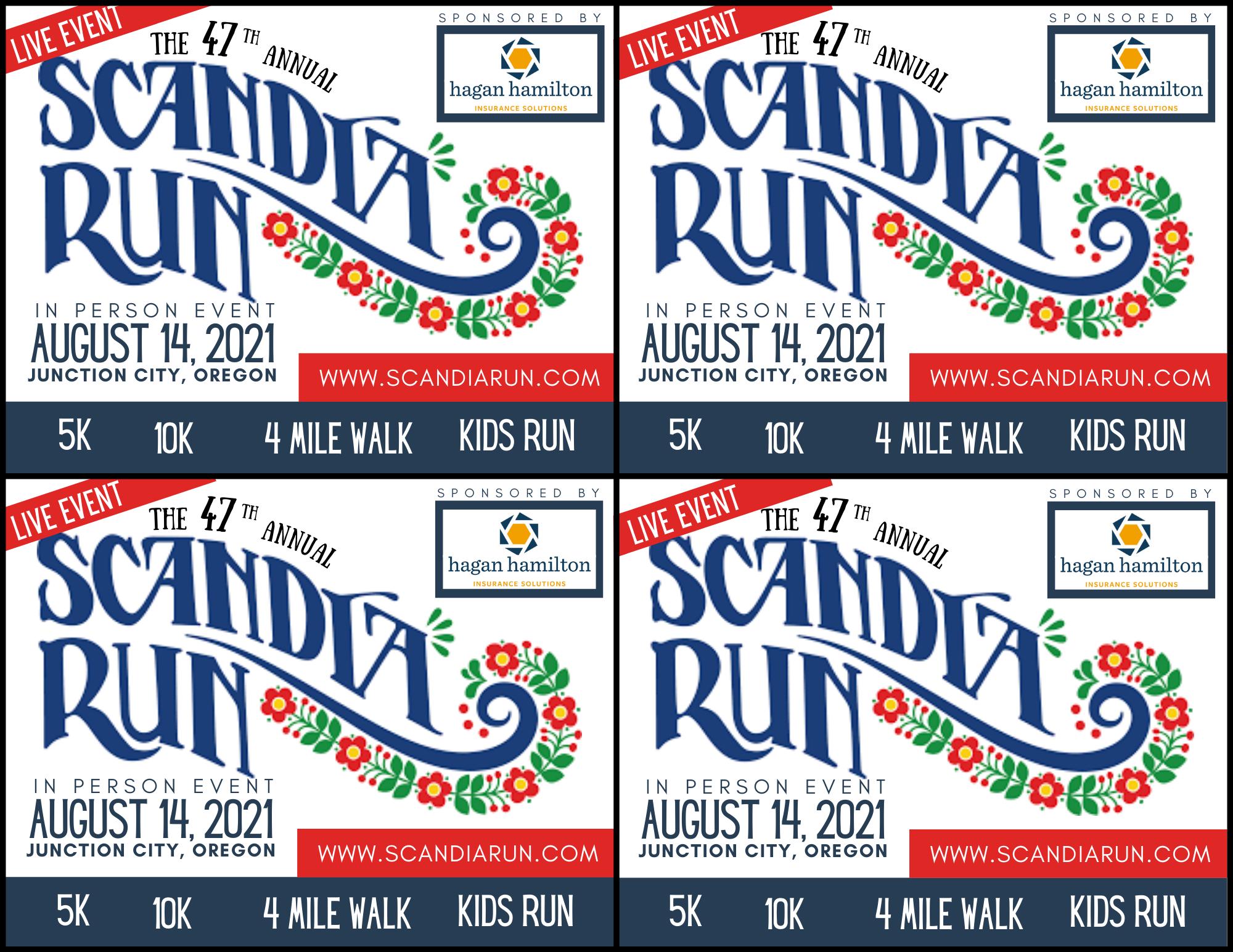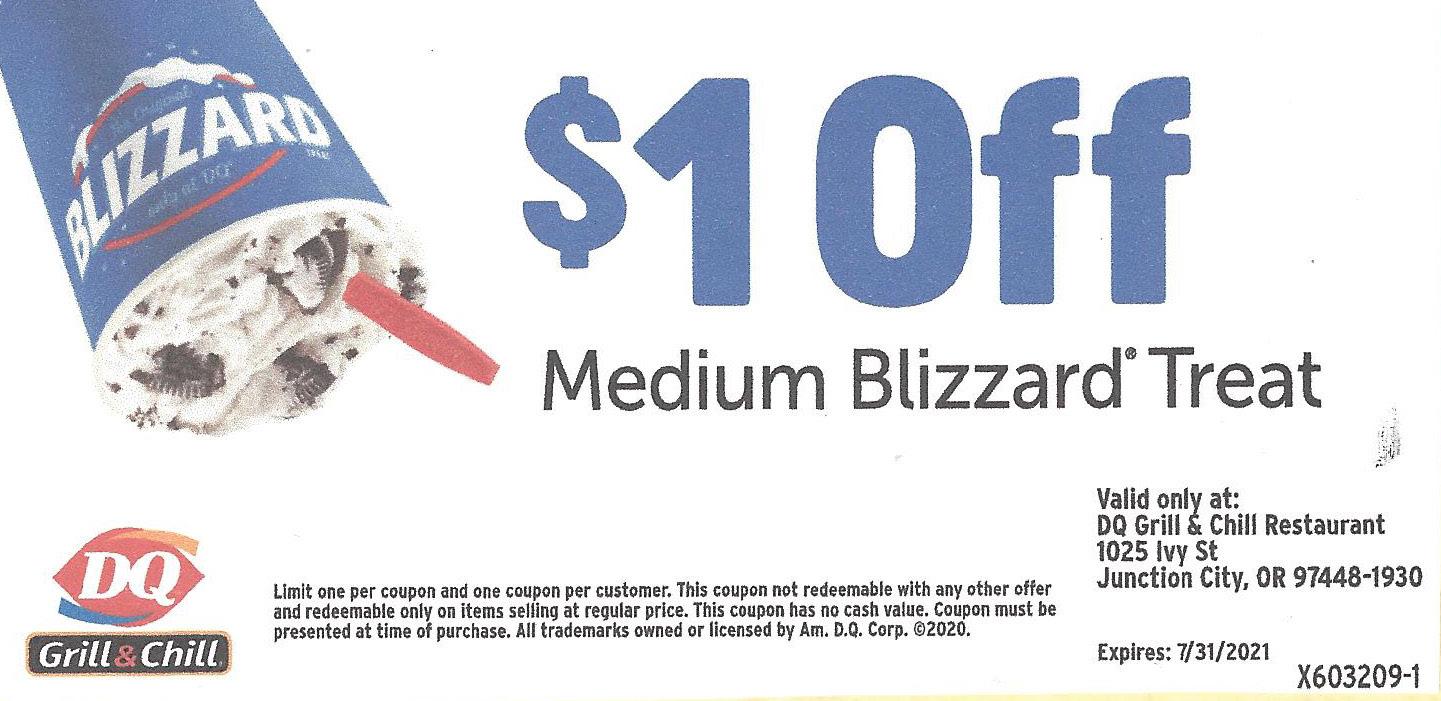
Fresh to you daily


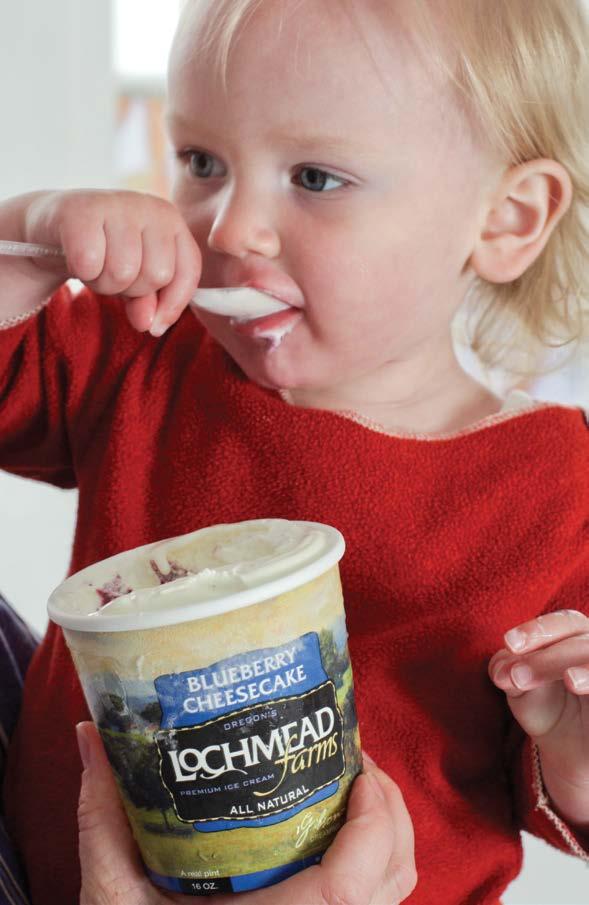









Welcome
2. Greetings from the President
Greetings from the Mayor
Meet the Boards
Community
Saint Lucia Scholarship
Gale Fletchall Award
Distinguished Service Award
MaryLou Finigan President’s Business Award
Danish Plate
Photos
City Birthday
Legacy Vendors
Children’s Activities
Trolls 19. Tomte Quest Scavenger Hunt
Festival
20. Schedule of Events
Map 25. Vendor List 26. T-Shirts
Scandia Singers
The Tirolean Dancers of Portland 28. Pageant Museum Scandinavia 29. Scandinavia 30. Sweden 32. Denmark 34. Finland 36. Iceland 38. Norway
Get Involved
40. Membership 41. Membership Pin 42. Members List
Save the Date!
Graphic Design by Brian Olson of Brian Olson Graphic Design. Photography by Katelyn LeGrone of KHL Photography. Printing by Oregon Web Press. Content editing, production and project management by SFA/SCF Board Member Rebecca MacDonald. Ad Sales by Madalena Nelson. Contributing writers: Marci Hancock, Debbie Lemhouse, Rebecca MacDonald, Glenn McCumber, Taryl Perry, Audrey Sherman, and Cassie Wicks. Many thanks to everyone who contributed to this year’s Festival Magazine, it could not have been done without you.
Hello, and welcome once again to our town of Forbin delsestad. As usual we have been working hard to bring you some extra joy on these August days. I would say ‘hot August days’, but last year we had been enveloped in smoke, rain, and molten lava, so who knows.

The hard work, stress, and exhaustion the board and our loyal volunteers put in to make this all happen are worth it when we see all of you here enjoying yourself. As we strive to do every year, we have added new entertainment and craft and food booths, but don’t forget your old favorites. And don’t forget we also couldn’t do this without you. All the people who come to our Festival. Between the support you give our vendors or the Festival itself, we couldn’t do it without the help.
So please join us again this year and enjoy it together. And this September come back down and help us celebrate the 150th birthday of the City of Junction City.
On behalf of our citizens, welcome to the Festival and to our city. For 61 years, the Festival has continued due to the commitment and dedication of our many Community Volunteers. During these 4 days in August, we are all Scandinavian.
So we invite you to enjoy all the danc ing, food, crafts, and other entertain ment of the Festival.
I would also like to suggest that you take the time to explore the City and visit our museums and local Businesses.
They will all have the ‘Welcome Mat’ out for you. We are so very proud of our community, our schools, churches and historic homes and buildings.
You are also invited to come back Sep tember 15-18 of this year to help us celebrate Junction City’s 150th birth day! We will have lots of fun activities and events to enjoy. On Saturday alone there will be a 5K Run, a Street Fair with hourly entertainment, dog pa rades and lots more, all ending with a community dance. You can check out the City’s website for more details.
In the meantime, enjoy your stay with us and all the excitement and plea sures that our Scandinavian Festival has to offer.
Beverly Ficek, Mayor Junction City, Oregon

This document certifies that
attended the 61st annual Scandinavian Festival in Junction City, Oregon, between August 11-14, 2022.
The above named has associated with Danes, Finns, Icelanders, Norwegians, and Swedes. They have eaten their food, danced their dances, joined in their activities, games and merriment, and is now considered by all intents and purposes a natural
The holder of this certificate is entitled to promote the Festival in future years and may return with others that they wish to see naturalized in such festivities.
Junction City Scandinavian Festival 2022
This volunteer Board of Directors is a 501(c)3 organization, a sister of the Scandinavian Festival Association which allows folks to make tax-deductible donations. Many of these donations are used to support local projects.

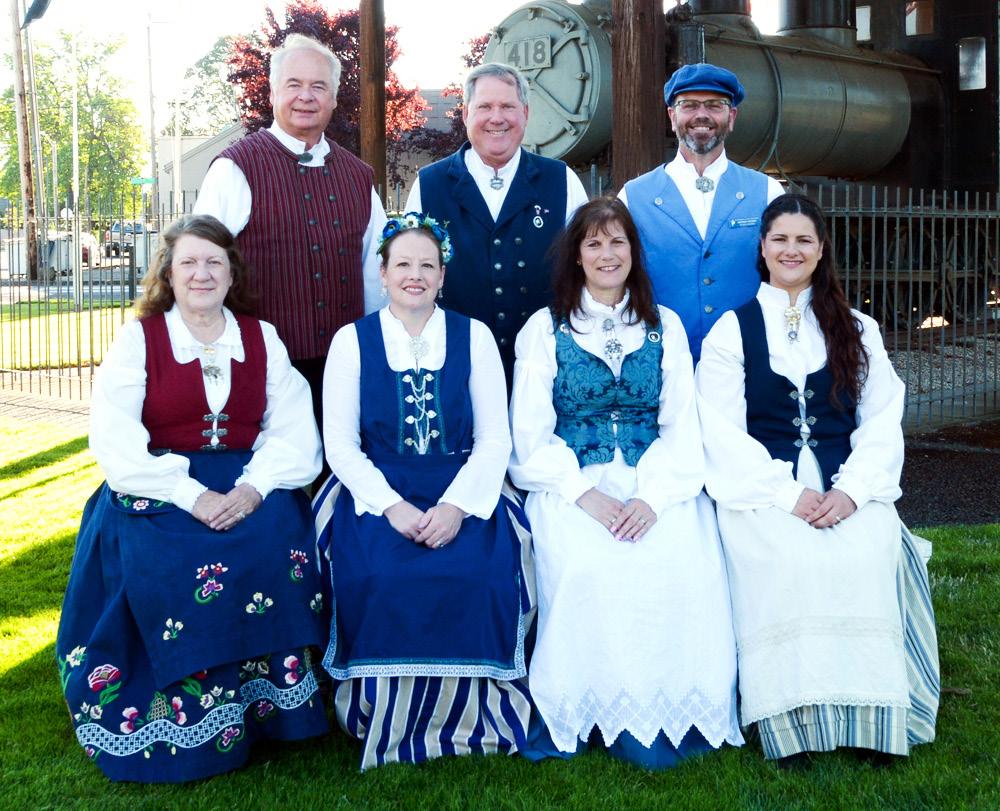
Currently our board is made up of seven members, Pres ident Debbie Lemhouse, Secretary Rebecca MacDonald, Treasurer Brad Lemhouse, and Board Members at Large Mathew Nelson, Brenda Peterson, Tom Peterson and Jilena Dotson (also SFA representative).
In addition to supporting the Junction City Scandinavian Festival, the Board also funds the St Lucia Scholarship, holds movie nights, serves an aebleskiver breakfast, gives a sewing workshop, hosts the Yule Fest Open House and organizes the annual Membership Dinner. The Board also designs and issues the annual Membership pin, which is sold online and at the Scandinavian Festival.
The Scandinavian Cultural Foundation works closely to gether with the Scandinavian Festival Association and share many common goals and ideals: namely the love for the community and the continuation of the Junction City Scandinavian Festival.
To support your community and help keep Scandinavian heritage alive and strong, please consider donating to our organizations by becoming a Member (information on pg 40) or volunteering for our many projects.
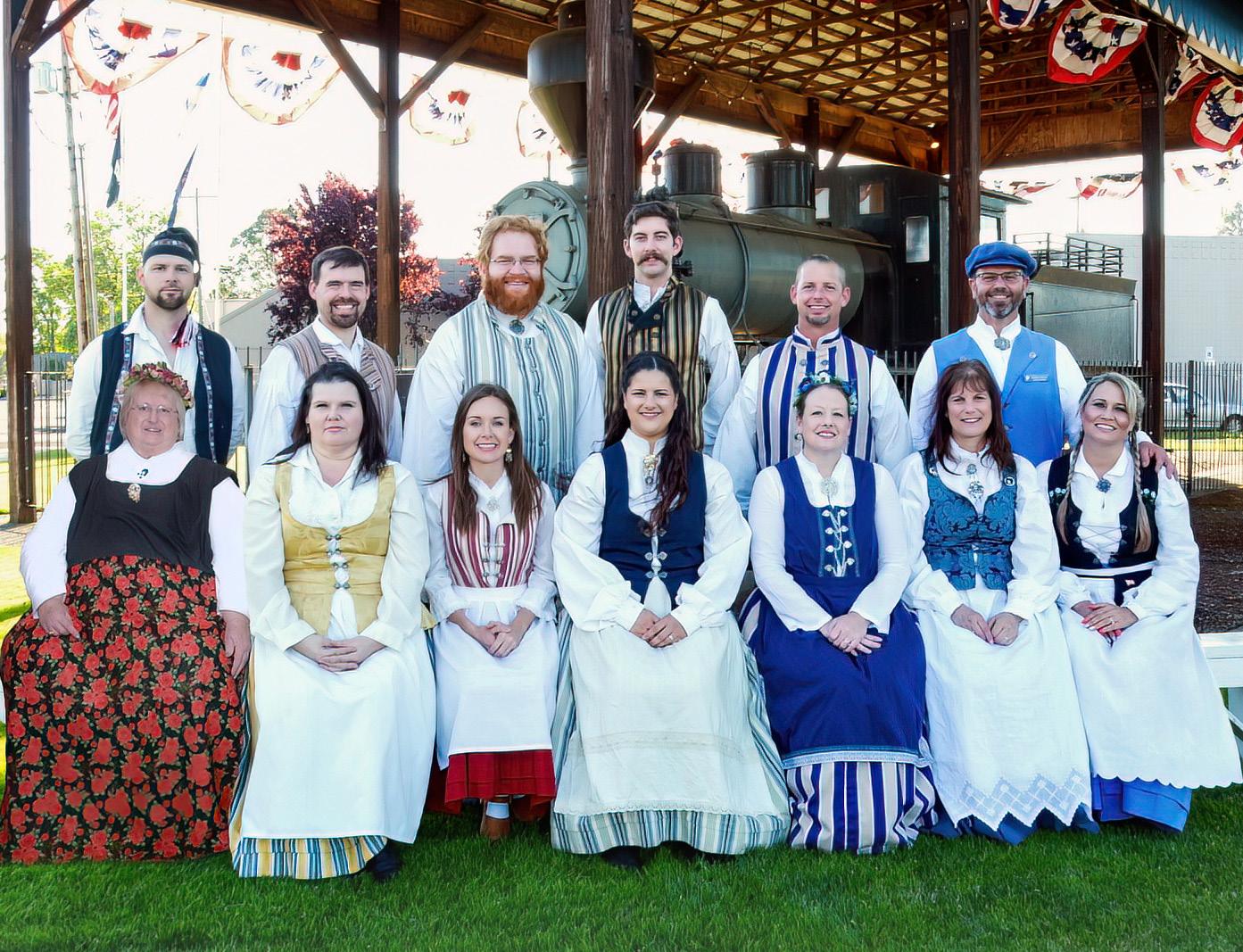
The Scandinavian Festival Association (SFA) Board is currently made up of thirteen members who are passionately dedicated to bringing the Festival to our community each year. Pretty much everything you experience at the Fes tival, from the delicious food to the beautiful flowers, to the talented performers, is here because of the time and creativity these folks pour tirelessly into planning and presenting this event.
As you can imagine it’s quite a feat to get our small town ready to host an amazing cultural celebration that is enjoyed by thousands of visitors each year. SFA board members are responsible for a myriad of tasks including booking entertainers and vendors, painting and repairing booths, coordinating volunteers, landscaping and maintaining the facilities and grounds year-round, and publishing the mag azine you are reading right now, to name just a few. These volunteers contribute hundreds of hours of labor, on top of their regular jobs and family responsibilities, in order to bring Festival to life every August.
The SFA board meets monthly almost year-round with just a short break after the Festival to rest and get ready for the year to come as well as a tiny pause during the holiday season. When September rolls around they are ready to start planning the next year’s Festival!
Are you curious about exactly what it takes to make this all happen? Community members are invited to join the board at the first meeting in September. This is a great opportunity to learn about some of the many pieces that need to fall into place in order for Festival to be a success. It’s also a chance to find out if there is anything you might be interested in helping with. Instructions for becoming a member can be found in this magazine, or you can also get more information at the Windmill. Thank you for your support!
If you happen to see a board member this week, please take a moment to thank them for all of the hard work they do behind the scenes every year to make this event possible. Their sincerest wish is that you enjoy Festival just as much as they love putting it on for you!
Every year the Scandinavian Cultural Foundation awards a $1000 scholarship to a local high school senior who has demonstrated outstanding involvement with the Festival. This year the SCF is pleased to present the St. Lucia schol arship to Susan Dover.
Susan began participating in the Festival as a small child when her older siblings introduced her to the children’s dancing groups at age 4. Over the past twelve years, she has performed not only with the Community Children’s Dancers but also in year-round groups such as Nordurljos and Kansantansijat. She has also
participated in some of the Festival’s nightly pageants. Al though she didn’t make the choice to join herself she said she couldn’t be more grateful that her family decided to get her involved in an event that has had such a positive influence on her life.
In addition to dancing, Susan has faithfully helped volunteer at the Festival for the past 9 years. She particularly likes to assist with set up and tear down which she says she loves almost as much as dancing itself. She thoroughly enjoys getting to work with her dance groups as well as other community members to help get the Festival ready and to help put it away when it is over.
Some of Susan’s favorite memories of the Festival revolve around performing and participating in community dance and the pageant. She notes “I remember going to community dance for the first time in 2017 and feeling mesmerized by the amount of people running on stage and knowing I get to be part of something that brought so much enjoyment for the community.”
Susan’s two sisters are still involved in the Festival, one is a dancer and the other is a dance group instructor, and both are volunteers as well. In the future, she plans to continue learning dance and to contribute even more volunteer hours to the Festival she loves so much. Susan says that the Festival has had an incredible impact on her development and even credits it with getting her through a very difficult time in her life. She says that she has developed many important friendships through her involvement over the years and adds “I am so honored to have been chosen to receive a scholarship from the organization that has meant so much to me throughout my life.”
Susan plans to use her scholarship to pursue Spanish studies at Lane Community College in the fall. On the behalf of the Scandinavian Cultural Foundation, we would like to congratulate Susan on this achievement and thank her for her years of involvement with and service to the Scandinavian Festival.
The St. Lucia Scholarship is open to any graduating senior within the Junction City area who has been involved in the Festival through dancing, volunteering, or work. If you are interested in applying, an application form can be found on our website at: https://junctioncityscandia.org/scholarship

The Gale Fletchall Award is an award given to an individual or group who have given a lifetime of service and love to the Scandinavian Festival. This year the honor goes to the Andresen Family and the Swedish Pancake Booth.
What started out as a way to pay their way through college, has turned into a 46 year enterprise! Glen Andresen, Gor don Andresen and Karsten Rasmussen started the Swedish Pancake Booth in 1979 while in their 20’s. Glen says that the brothers learned to make the crepe like pancakes from their paternal Swedish-American grandmother in the 1960’s. She once admitted that her grandson’s pancakes were better than hers! Once their maternal grandmother even hired a taxi to take her from McMinnville to Junction City just to have some of their pancakes. During the Festival they serve these fresh, hot Swedish pancakes with either strawberry or blackberry jam, which Glen hand makes, as well as lingonberry jam from their iconic blue and yellow booth.
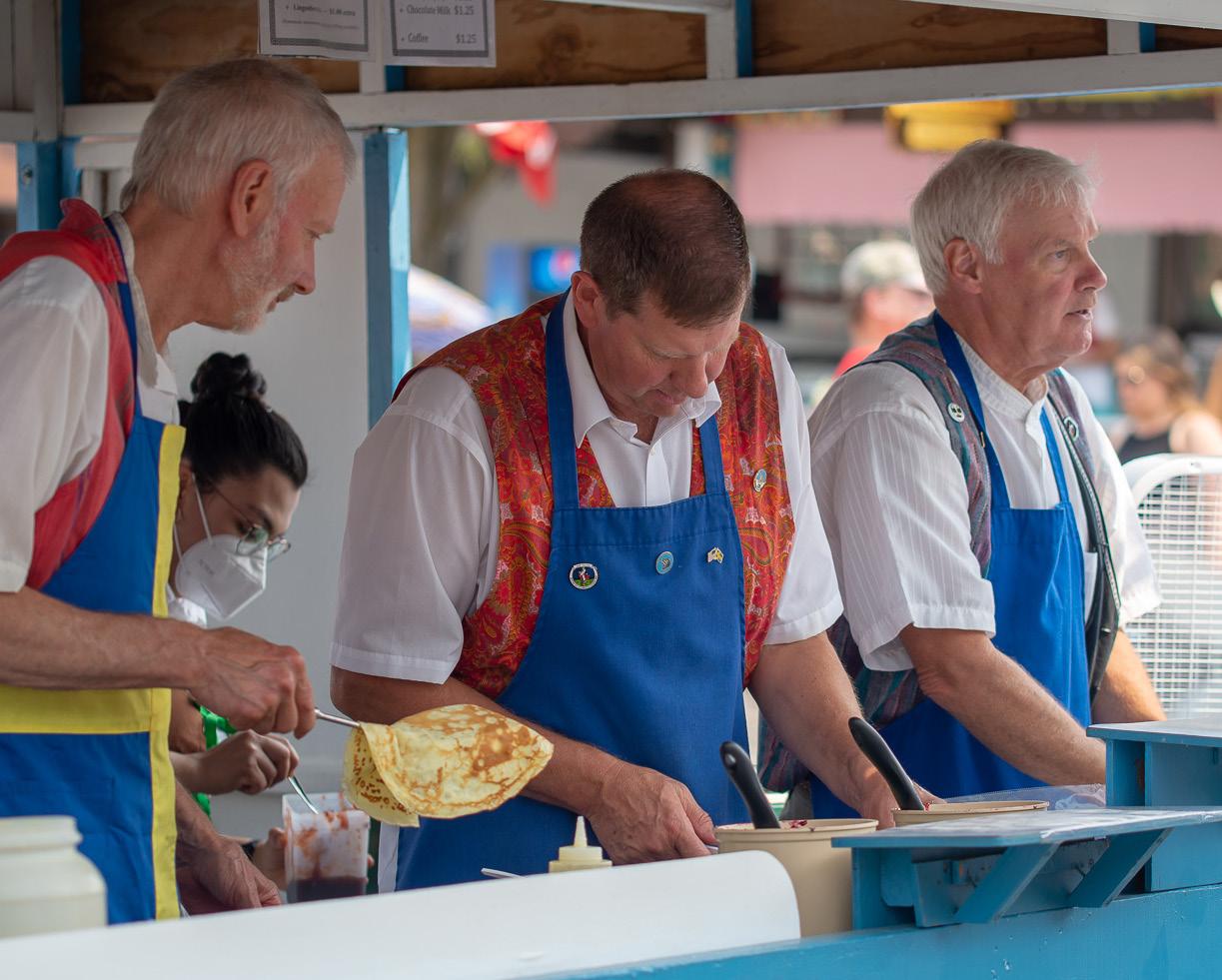
The booth is currently located at the corner of Greenwood and 6th Street but their original location was by the Post Office near the Mall Platform. In the early years the brothers would recruit their parents, Vern and Alves Andresen for evening booth duties so they could participate in community dance at the Mall Platform. Vern has also helped with the assembly of the booth for many years. Other family mem bers have helped as well; Gordon’s wife Gayla has been a
batter maker while Gordon and Gayla’s two children, Danica and Jake, have also assisted in the booth. A third brother, Bruce, joined the team after Karsten moved on to devote more time pursuing his career. Bruce took over some of the duties including cashier, making him the “taker” while Gordon is the “maker” and Glen is the “baker”! The brothers do switch around but Gordon and Glen’s roles have been the same for most of the years they have served in the Swedish Pancake Booth.
The brothers have had a great run. Reminiscing, Glen said that he’s “enjoyed working with Gordon and Bruce over the years” and that he “has appreciated all that the Festival Board has done for them” and have “always been there to help, whether it was a blown fuse or a sewer issue”. Now after 46 years of working the 12-hour days of Festival and behind-the-scenes preparations which included assembling the booth and making the jam, they have decided it is time to retire from the Swedish pancake-making business. The 2022 Festival will be their last. In anticipation of the last year of operation, Bruce is having some coins made to commemorate this booth’s momentous run. It will be about the size of ½ dollar and have a Viking ship on one side and the words Andresen Bros on the other side. It will also have the dates of operations and the words, JC Scandinavian Festival.
The Andresen brothers and the Swedish Pancake booth will be sorely missed but they have certainly earned a rest from their hard work! So it is with a great deal of gratitude that the Junction City Scandinavian Festival Board is proud to award the Gale Fletchall Award to the Andresen Family and the Swedish Pancake Booth!

The Junction City Scandinavian Festival is made possible by community involvement, and dedicated, passionate volunteers. The Festival was started as a community collaboration, and has functioned that way for sixty-one years. Many volunteers have grown up dancing and working at the Festival, as they become adults they start to contribute in ways that improve the event.
The Distinguished Service Award is annually awarded to an individual or organization that has gone above and beyond in serving the event. This year’s award goes to Katelynn LaGrone, of KHL Photography. Like many, Katelynn grew up dancing as a child, falling in love with the magic of the Scandinavian Festival. She danced for almost a decade, and as she became older, she took on more serving roles. She has been involved with the First Baptist Church booth. She also helped fundraising for the Moose Lodge in their corn booth, and as a high schooler, she worked to fund raise for Future Farmers of America (FFA). More recently, Katelynn was a member of the Scandinavian Festival Board of Directors, the core group of volunteers that coordinate everything at the Festival, serving in 2021 and 2022.
Recently, Katelynn has utilized her skill as a photographer to document all aspects of the Scandinavian Festival. She saw the need to capture special moments of the Festival from the trained eye of a professional photographer. No one asked her to show up before Opening Ceremonies to capture the first moments of the Festival, or to sit in the direct sun all day to get the best shots but she has, and plans to continue. She made sure to study the program and thoroughly record all four days of the event.
Last year, the Junction City Scandinavian Festival was in need of a new website. The Board wanted this website to really show and express the feeling of the Festival. One
method to communicate that story was through photog raphy, and Katelynn had that covered. She gladly gave the web design team full access to whatever pictures were needed, without asking for anything in return. She donated her work, because she wanted to give back to an event that meant something special to her. Her photography also graces the pages of the magazine that is produced each year. She has captured the little moments, to the big ones and her photography really shows a holistic view of our unique town.
When asked what her future goals are, in regards to her involvement in the Scandinavian Festival, Katelynn replied, “One of my goals is to give my kiddo(s) a chance to enjoy the Festival like I have all these years.” Katelynn grew up with a grandmother, Meredith Skiller, who encouraged her to be involved. Her grandmother would make her costumes, and also volunteered in booths. Katelynn learned from a woman who was a great example of community service in action, and now she is setting the same example for her daughter. Through this generational love, this local event has lasted and flourished.
“Festival has always been a place to gather with friends and family, as well as a place where you’d run into people you haven’t seen in a while,” Katelynn explained. She is right, it’s a special event where the community connects over heritage and the town is reminded of its Scandinavian roots. This incredibly unique event couldn’t happen without the volunteers, like Katelynn and community members banding together to serve and make this Festival a reality.
Since 1961, the Junction City Scandinavian Festival has celebrated our town, and its heritage. The Mary Lou Finigan President’s Business Award is presented to a local business that has shown their dedication and support of the Fes tival. This year’s award is being given to several businesses who all work together, owned and operated by a local family in Junction City. These businesses are Lochmead Farms, Lochmead Dairy, and Dari-Mart. These family-owned companies have long participated in the Festival, both as companies and as individuals.
Gladys Halkjar was the daughter of Danish immigrants. Her family roots were steeped in farming. In 1935, Gladys mar ried a vocational schoolteacher named Howard Gibson, who soon turned away from the field of education, and found himself in the field of agriculture. Howard and Gladys broke ground on their farm, located north of Junction City, in 1941.
Following Howard and Gladys’ lead, four out of their five children found their niche in the family business. Three brothers took charge of their own branch of the business - farming, dairy, and processing. Daughter Pat Straube and family moved back to the area from Portland in 1972. She soon found herself working in the ever-expanding business. Since Pat’s move back home, she has not missed a Festival. 2022 will mark the first time since 1972 that she has not attended all four days of the Festival, due to a family wedding.

The family has been involved in many capacities in the Scandinavian Festival. “I guess it’s just the right thing to do. We like the Festival, we like our town, and like people coming to our town and showing it off”, Pat expressed. The family have helped in many ways over the years at the Festival, including: working in the former Business and Professional Women (BPW) booth, the Soroptimist Wine Terrace, in the Windmill, and, being OSU graduates, they have helped at the daily breakfast that that was served in the early years of the Festival.
For many years, Dari-Mart convenience stores have helped distribute the Festival magazines at their 44 stores, free of charge. This enables the Festival to reach thousands of potential patrons, without adding strain to an already tight publicity budget. This creates a way to access more visitors for the Festival. In the end, this support helps the local vendors at the event. In addition to distribution, Dari Mart helps to support the Festival by purchasing advertising space in the magazine.
The mission of the Festival is to attract visitors to stimulate our local economy. Revenue from these ad sales helps pay to produce the magazine, helps to support activities and events sponsored by the Festival throughout the year, and helps attract new customers to those businesses. It is a blessing to have local businesses work together, with the goal of supporting our community.
Lochmead Dairy goes above and beyond in serving their customers. Several of our vendors use their products at the Festival. They accept late night orders, and provide early morning deliveries. Not only do they provide this great service, but they go the extra mile by restocking the booths prior to the vendor arriving each morning. Dari-Mart takes pride in exceeding expectations when it comes to customer service.
The Junction City Scandinavian Festival is beyond grateful for the longstanding partnership and support. We are honored to present Lochmead Farms, Lochmead Dairy, Dari-Mart, and the Gibson/Straube family, with the 2022 Mary Lou Finigan President’s Business Award. Their love for our community, and tireless support for it, shines brightly as an example for all.
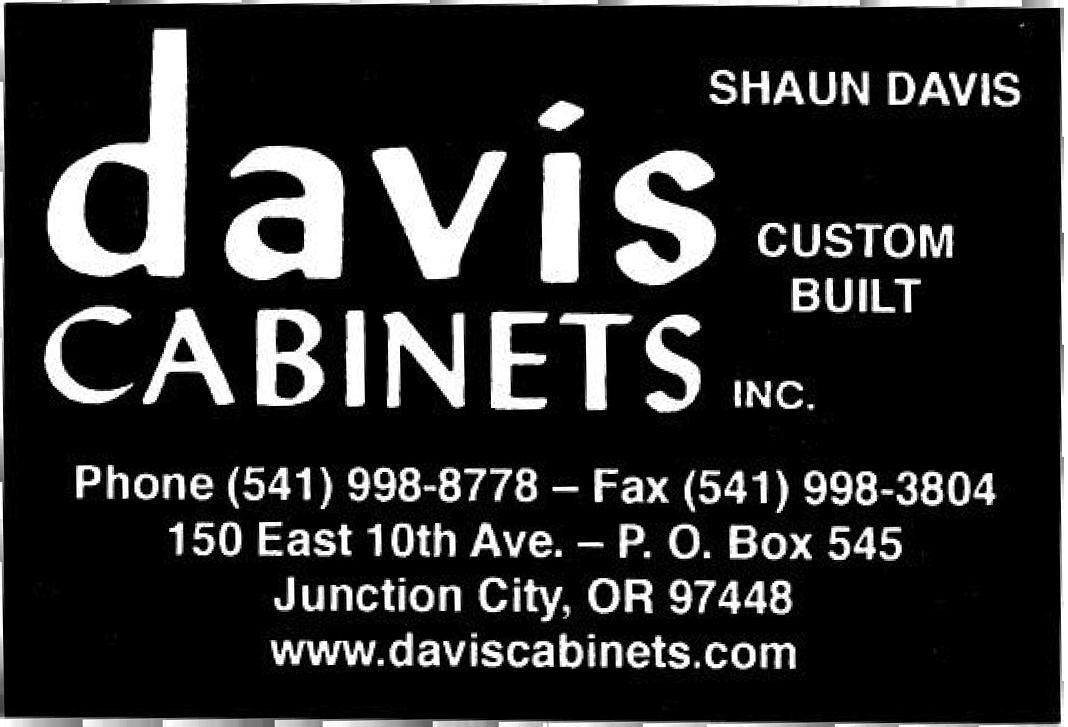
Thank you, to the local businesses in Junction City! For a short time in August, the streets are packed with new things to buy and taste and see, but our local businesses are here year round and are so very important to our community. Make sure to stop in and look around those businesses, there’s so many interesting things inside these shops, and even more so, the wonderful people that run them!
Danish Plate BY DEBBIE LEMHOUSEFor the 61st Scandinavian Festival, the Junction City Art Association is painting a plate to commemorate this year’s Festival, and we are excited to announce that Roderick Neswick is the artist. Roderick has been an artist for 57 years and has been with the Art Association for 3 years. His works have been shown in 49 galleries from Hawaii to New York and he has taught sculpture and oil/acrylic painting for 32 years. Roderick says he works in many mediums and “likes them all”!
The plate depicts the Frederiksborg Castle located in Hil lerod, Denmark. The castle is surrounded by snow-covered cobblestones with the streetlamps capturing the twinkling eyes of two palace cats. Roderick Neswick’s design is a larger replica of a dated Royal Copenhagen’s 7 inch dessert plate that is released annually. These annual plates, always painted in blues and whites, have been produced every year since 1908, and each year after Christmas Eve the plate’s mold is discontinued.
The plate will be gifted to the Festival at Opening Ceremo nies on Thursday, August 11th. It will then be on display at the Tri-County Chamber of Commerce in Junction City and then brought to the Gale Fletchall Hall when next year’s plate is painted.

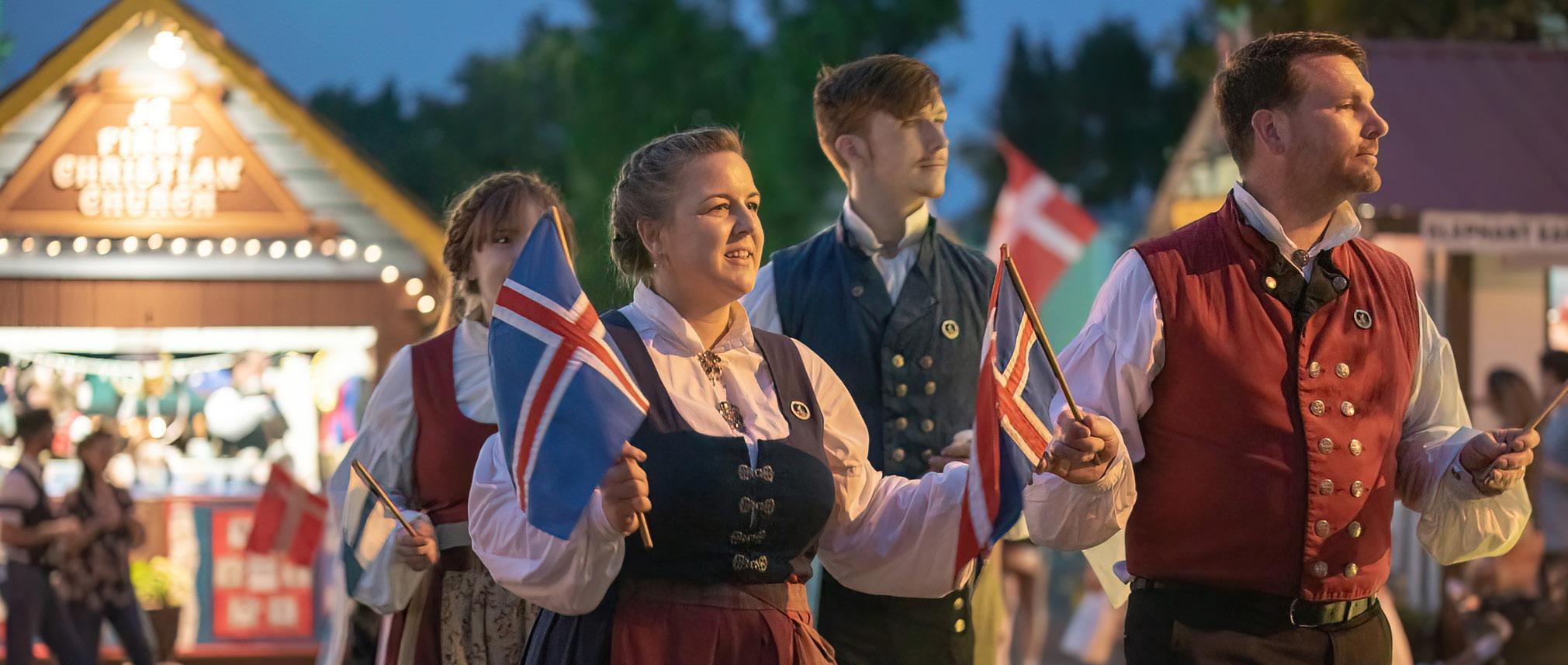


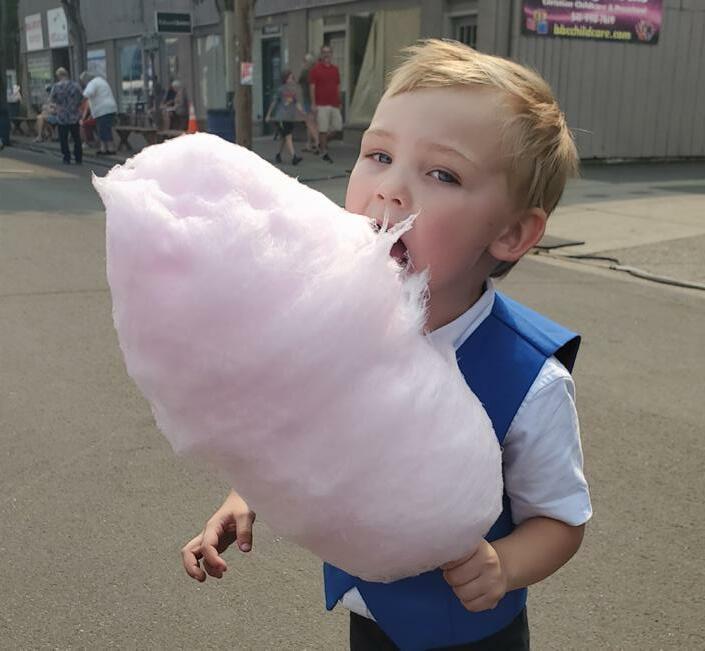
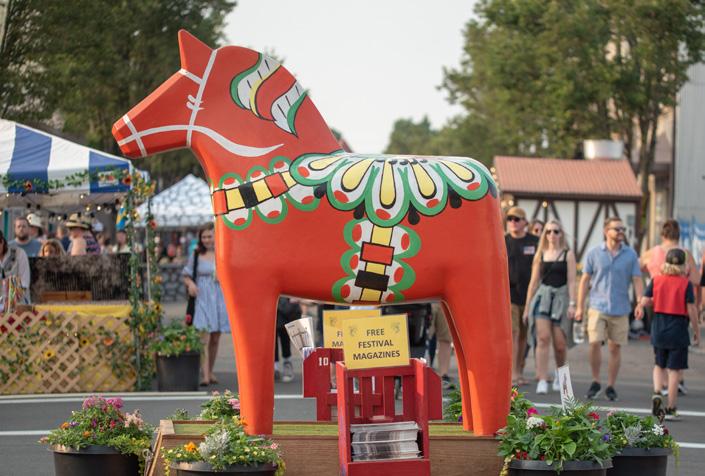



year Peoria Gardens creates the gorgeous flower pots that we all enjoy throughout our Festival. To make sure these beautiful flowers don’t go unloved after the Festival is over, we choose to offer them to our community. We keep the price low because it’s not meant as a fundraiser, it’s just another way to share the love.
Flower sales will be Monday, August 15. It’s first come, first serve, and we cannot hold or deliver the flowers. The location of the sale will be posted on our social media, so make sure you follow us on Facebook or Instagram.



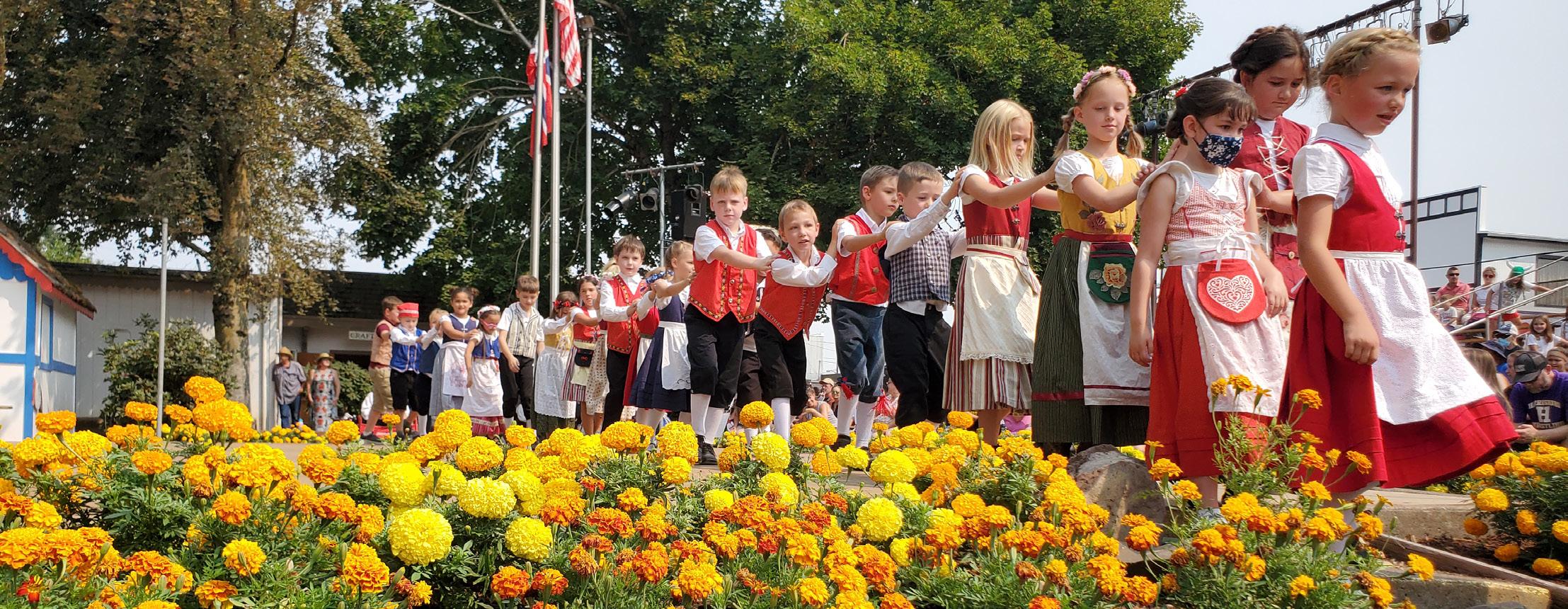
Woof, hello! The pets of the Scandinavian Festival board have a message fur you. Once a year, we make our bipeds leave the nest fur a week fur some much needed shut eye. They go off and do something they call Furstival, and we get the oppawrtunity to relax without their noise and pestering. It’s pawsitively purrfect.
Also, we found an ordinance in the city code that their Furstival is essentially an open air restaurant and they can’t have our fluff and fur and *ahem* bathroom habits around, but we know it’s just an excuse to get a nap.
Junction City is celebrating its 150 year birthday on September 15-18, 2022!

Junction City began its history as a small town in hopes of a future railroad junction. Even though the railroad station did not come into Junction City, the town continued to thrive. In 1891 James A. Bushnell built a block-long hotel on Front and 7th Street which included an opera house. That building block burned down in 1915 but you can still see many historic buildings in the Junction City downtown area. In 1961 the Scandinavian Festival was started in hopes of reinvigorating the town after construction of I-5 in 1960. This brought in many visitors to the city and is one of the things that Junction City is known for. Other events that the town boasts are the Annual Light Parade, the Function for Junction and the Daffodil Festival. The city now houses a population of over 6000 and continues to grow!
Some of the exciting activities planned are:
• Thursday - City offices open house after 5pm with ice cream and cake in the Council Chambers. Open house at Public works from 3-5pm. Downtown historic tours through evening.
• Friday - Alumni night at Junction City High School Football game
• Saturday - Street Fair on 6th Avenue west of Ivy Street to Maple. Entertainment at Washburn Park from 11 -4pm. Community Dance at Scandinavian Festival grounds held by the Scandinavian Festival Association from 7-10pm.
• Sunday - City BBQ at Laurel Park from 1-3pm. Junction City Opry sponsored at the Junction City Grange at 4pm sponsored by the Junction City Grange.
Everyone is welcome to join in these activities and however you celebrate the Sesquicentennial, the Committee hopes everyone will have a lovely time at the City’s birthday!
For some it’s the dancing; an old recording played a thou sand times or more, the same steps but new partners, new smiles every summer. For some, it’s their favorite flavors; hot, savory, cold, sweet; worth waiting for in line, in the sun, taking it to your favorite spot—by the train? a stage? Or is it wherever is nearest, because you just won’t wait anymore.
I remember being little and recklessly weaving through the crowd around the Windmill. I couldn’t see much more than belt buckles and belly buttons, but, because landmarks rose above the crowds, I knew where I was. The Windmill itself, of course, the very heart of Festival, stands tallest but around it are the old booths, old friends, new every year to each new person who finds them.
Kid-me always dragged whatever grownup I had on hand to the Elephant Ear booth. Dottie Chase has been bringing Elephantorers to us since the very first Festival in 1961. In 2021 she won the Gale Fletchall Lifetime Achievement Award in recognition of that dedication.
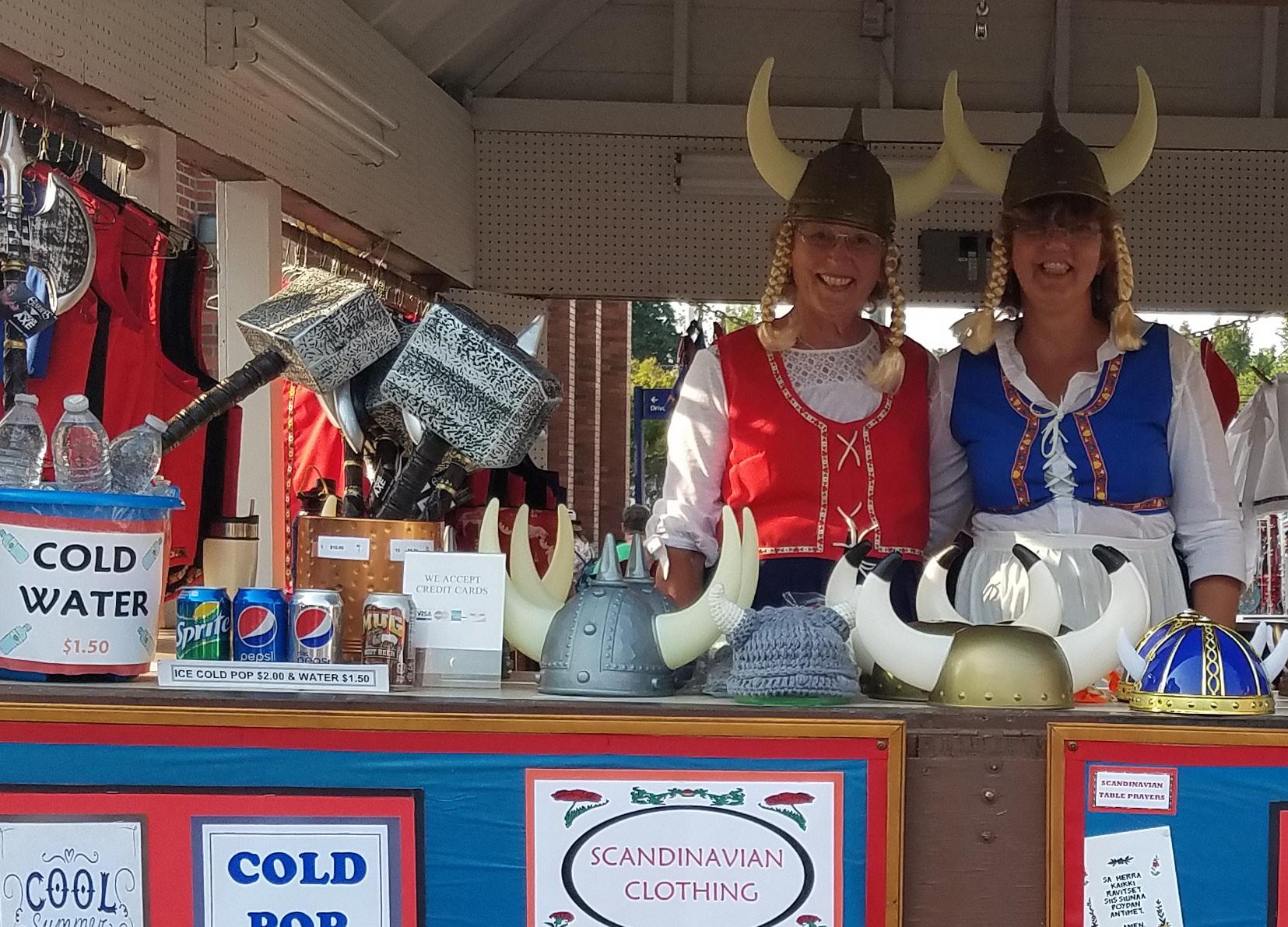
Across Greenwood is First Christian’s booth, where you could get costumes from the beginning. Generations of people have handed down those vests and aprons. Around the corner, the Andresen brothers, Glen and Gordon, still make the Swedish pancakes and Lefse, which they and Karsten Rasmussen started selling in the early 70s for college money.


The Girl Scouts, off another shoulder of The Windmill, have been keeping everyone in ice-cream for more than 40 years, and have served in other ways before that.
Another booth has always been at the center of Festival, and it’s off the Southeast corner of the Windmill. Faith Lutheran has been serving Æbleskiver since 1961, and never missed a Festival until 2021.

Last year if you were trying to make your way through the crowd you might have felt a little disoriented, because something we’ve all counted on couldn’t be there. Many of our favorite booths (and, in fact, Festival itself) are volunteer-run, with years of service given so we can enjoy Festi val. Few from the start are still doing it. Most of the work has passed from generation to generation.
We’re in a torch-passing moment now. The Æbleskiver booth couldn’t bring that reliable delight to Festival last year, even considering different options; the real difficulty was volunteers. This year also. And though there are plans to bring this booth back, and in a sus tainable way, seeing that spot empty is a powerful reminder that it takes people to make all this happen. And that we all miss out when not enough of us pitch in.
Successions of people have carried on this work for years, for all of us. But a torch-passing takes at least two pairs of hands. So I invite you to join those who make Festival happen. Find something at Festival that you love, and find out what you can do to support it. What can you volunteer? How can your organization be involved?
And if you can help, talk to the Windmill. They’ll have information about where help is needed, and you’ll be able to leave your information with them.
We all already support Festival, even by strolling through. And many volunteers already help, set up, run, and clean up when it’s over. When our sound shack burned up, people showed up to rebuild. So I hope that you’ll consider both what Festival has given you, and what you might be able to give; for all of us. For all of us now, and for all of us who will have favorite Festival memories in the future.
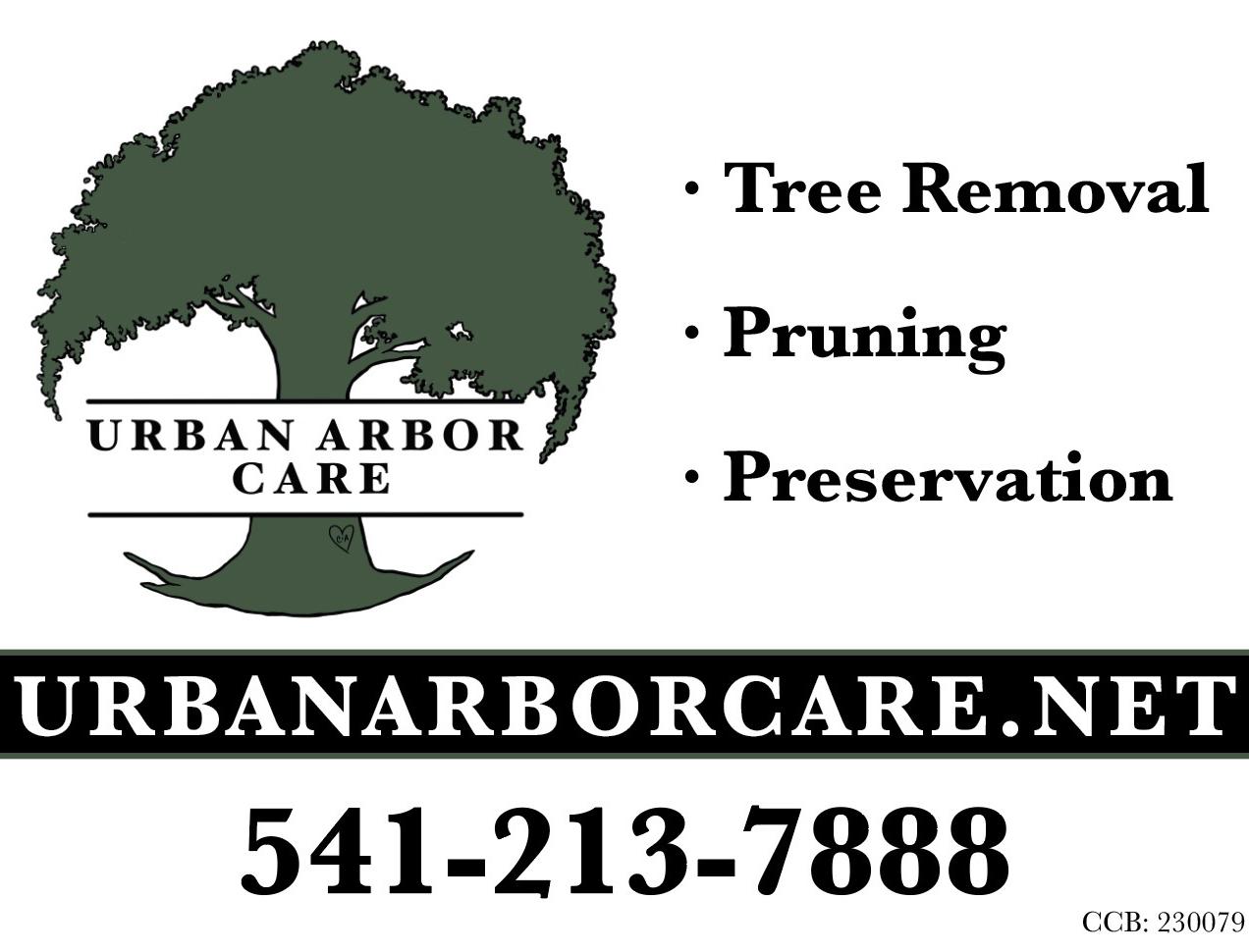




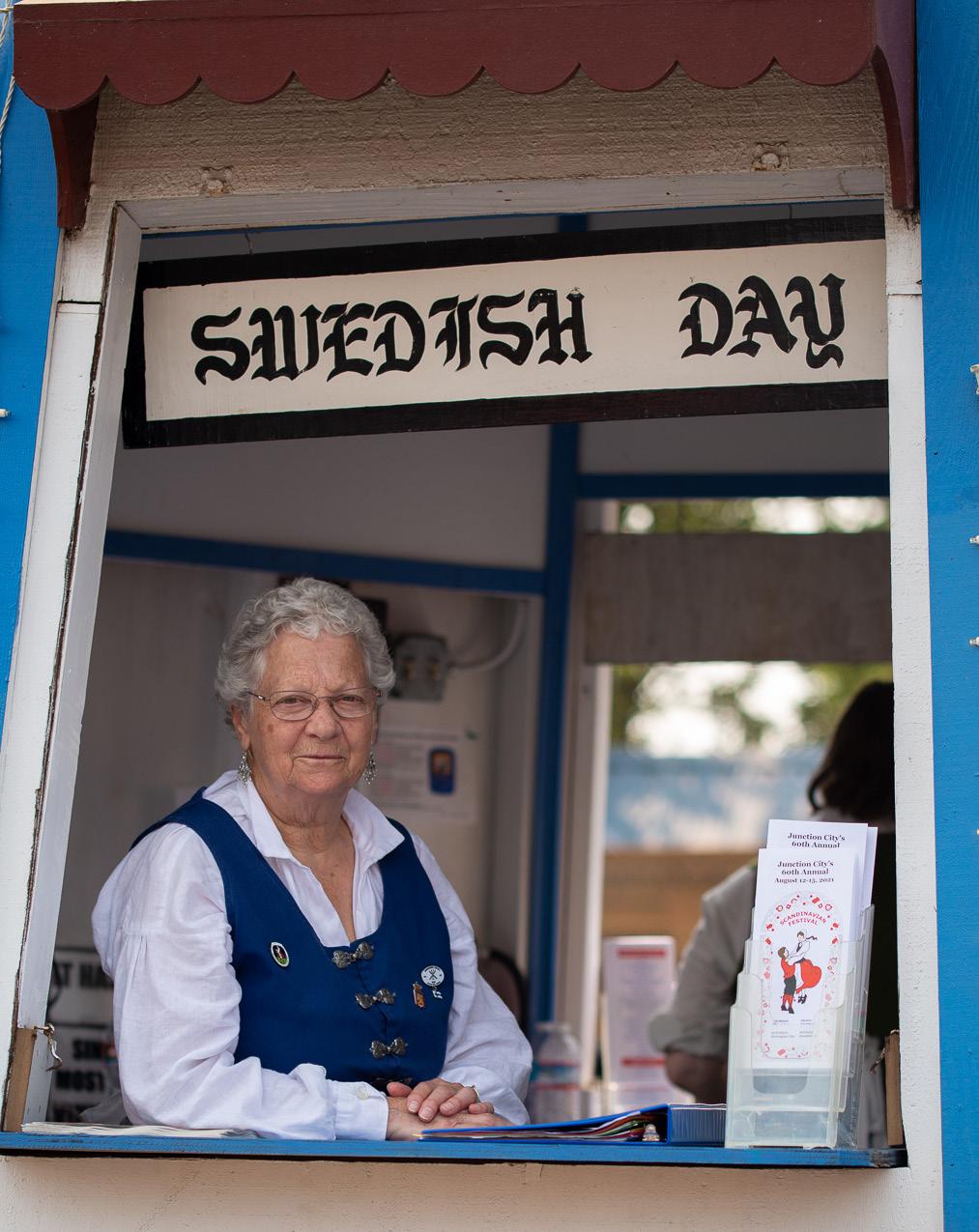
As you are strolling through the streets of the Festival this week, don’t be surprised if you are greeted by a cu rious creature or two lurking in the shadows or popping out from around the corner of a food or craft booth. These colorful characters are none other than our very own Junction City Trolls and they have been visiting us at Festival time for many years. They might look ugly, or even a little scary, but don’t worry, they are actually quite friendly fellows.
Unlike their counterparts back in Scandinavia, our Festival Trolls are quite harmless. They prefer making mischief to hoarding gold or tricking princesses into marrying them. They are still a lively bunch though and you can often see them dancing, arguing, or even throwing a Scandi-fit or two. If you are lucky enough to see one, feel free to go up and say “Hello!”. Don’t be offended if they don’t answer back, though. Our Trolls are sadly unable to talk to humans, and you would probably not understand what they said, even if they could!
Our Trolls have no idea how terrifying and frightening they look. In fact, on the contrary, they think of themselves as quite handsome and absolutely adore having their photos taken. They even set aside a little bit of time from their busy mischief-making routines to pose with guests at the Arch way Stage each day of the Festival. (see the daily schedule to find out when they are available on pg 20). Whether posed on the stage or in the “wild”, we would love to see your Troll pictures. Please feel free to share them with the hashtag #JCScandiTrolls so we can all see how handsome you and your Troll friends look!
Remember, if you are lucky enough to see a real live Troll during the Festival, please be sure to be kind, friendly, and courteous so they feel welcome and keep coming back to visit us every year!
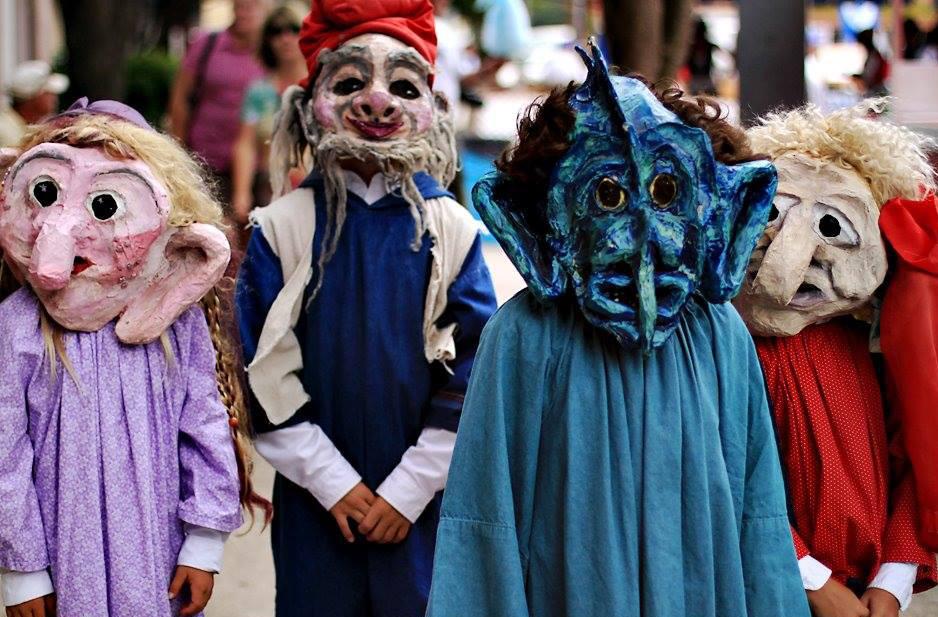
If you go to a Scandinavian bakery, you could Finnish a Swedish Danish. There’s Norway I would make that up!
What do you call somebody that says they’re Swedish but really aren’t?
An Artificial Swedener!
What’s the most common dog in Denmark?
The Great Dane
Which Scandinavian would win our aebleskiver contest?
Whoever Finnished first!
We’ve been searching for our missing tomte, have you seen them? While enjoying the Festival this year, please be on the lookout for our newest, smallest troublemakers, the Junction City Scandinavian Festival tomte!
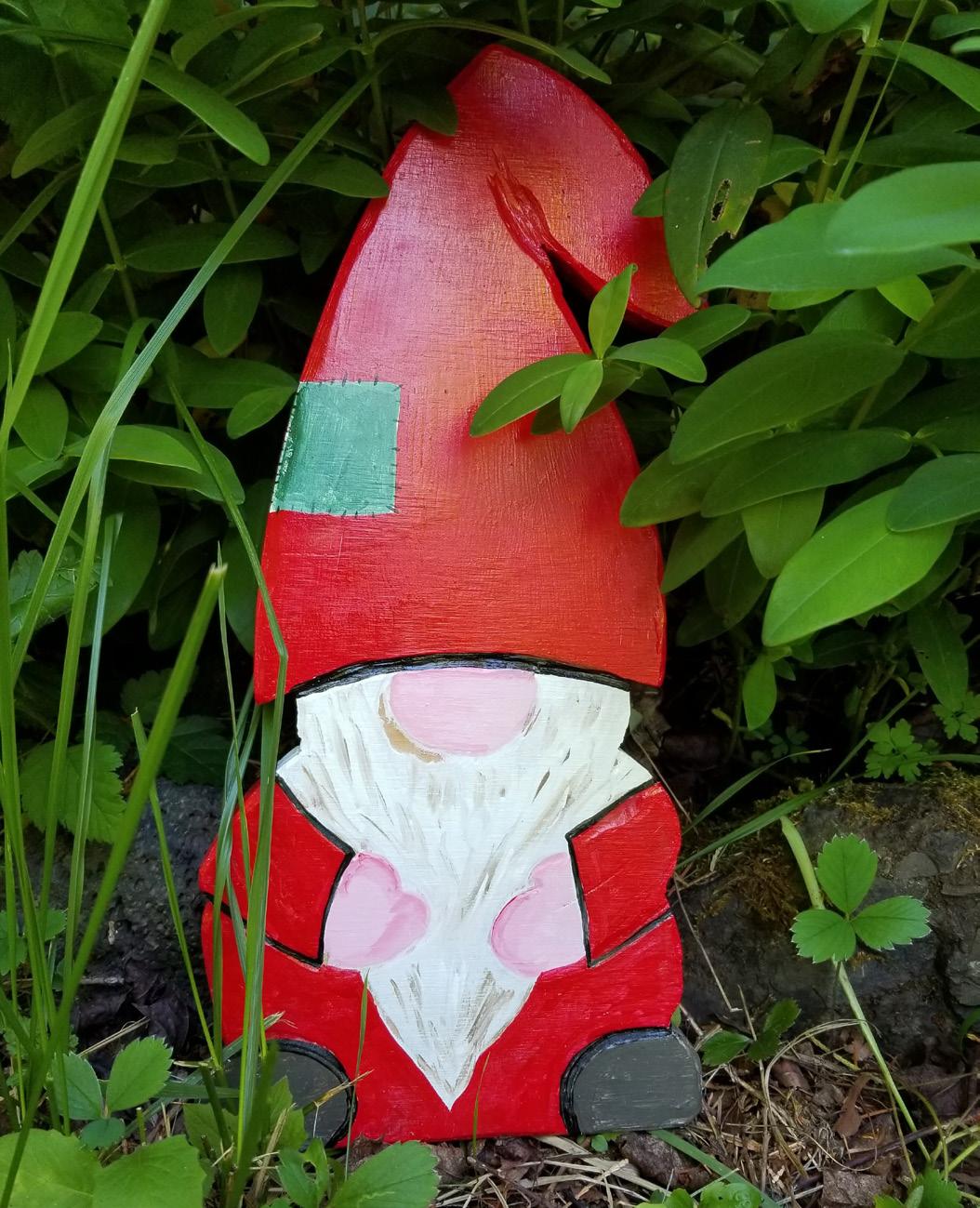
3 red, 3 green, 3 blue, and the hardest of all to find, the golden tomte!
They are known by many names in many places. In Danish and Norwegian they are known as nisse, in Swedish they are known as tomte, and in Finnish they are called tonttu. But no matter what you call them, they are quite a mischievous creature. They are guardians of farm animals and children but are rarely seen, though we’ve heard rumors our tomte are so curious about all the children around Festival that they can be seen peeking out at the crowds from behind the flowers, booths, and other sneaky hiding spots!
Go through the Festival and take pictures of the following list. Must be under 16 to receive a prize, but any age may participate! Bring your phone/camera to the Windmill after finishing the hunt and show the Windmill staff your pictures and get a Scandinavian coloring book! You may only participate once during the 2022 Festival.
Take a picture with a tomte (gnome)
Take a picture with a wooden soldier
Take a picture by the viking ship
Take a picture by the Finnish train
Take your picture with a performer
Take your picture eating your favorite treat
Take your picture with a troll
Take your picture with a windmill
Take your picture with the cut outs
Take a picture with the Little Mermaid
Can you find them all?!
10:00 a.m.
• Processional & Opening Ceremonies, Festival Park Stage
• Demo: Long Tom Spinners & Knitters, Junction City, Archway Stage
• Demo: Blacksmith, Cottage Grove, Finnish Train
• Demo: Clog Carving, Wood burn, Finnish Train
11:00 a.m.
• J.C. Scandia Children Danc ers, Junction City, Festival Park Stage
• Children’s Area Opens, Courtyard
a.m.
• Scandinavian Baking Imple ment Demo, Junction City, Archway Stage
12:00 p.m.
• Demo: Learn to make Krum kake, Junction City, Archway Stage
12:30 p.m.
• Hostendans, (Instrumental), Eugene, Festival Park Stage
• Demo: Scandinavian Fiber Arts, Eugene, Archway Stage
1:00 p.m.
• Scandinavian Storytelling, Junction City, Festival Park Stage
• Nordurljos, (Dance) Junction City, Mall Platform
1:30 p.m.
• Learn Scandinavian Dances, (Interactive) Patrick Mc Monagle, Seattle, Festival Park Stage
• Demonstration: Let’s Speak Danish, (Interactive), Mall Platform
• Demonstration: Scandina vian Fiber Arts, Courtyard
2:00 p.m.
• Take a Photo with a Viking, (Interactive) Junction City, Archway Stage
• Demonstration: Scandina vian Fiber Arts, Courtyard
2:30 p.m.
• Kubb Lawn Game (Interac tive) Junction City, Festival Park Stage
• Community Dancers, Junc tion City, Mall Platform
• Take a Photo with a Troll, (Interactive) Junction City, Archway Stage
• Demonstration: Scandina vian Fiber Arts, Courtyard
3:00 p.m.
• Kansantansijat (Dance), Junction City, Mall Platform
• Noah Brenner, Celtic Harp ist, Eugene, Archway Stage
3:30 p.m.
• Nordurljos, (Dance) Junction City, Festival Park Stage
• Costume Show, Junction City, Mall Platform
• Demonstration: Clog Carv ing, Woodburn, Archway Stage
4:00 p.m.
• Skandia Leikarringen (Dance), Junction City, Festi val Park Stage
• J.C. Polka Band, Junction City, Mall Platform
4:30 p.m.
• J. C. Adult Recreational Folkdancers, Junction City, Festival Park Stage
5:00 p.m.
Kansantansijat (Dance), Junction City, Festival Park Stage
• Fiddle by Athena, Junction City, Mall Platform
5:30 p.m.
• J.C. Scandia Children Danc ers, Junction City, Festival Park Stage
• Learn Scan. Folk dancing, Gummi Kylling, (Interactive) Junction City, Mall Platform
6:30 p.m.
• Scandia Singers, Junction City, Mall Platform
7:00 p.m.
• Skandia Leikarringen (Dance), Junction City, Festi val Park Stage
7:30 p.m
• J. C. Adult Recreational Folkdancers, Junction City, Festival Park Stage
8:00 p.m.
• D’n’A (Instrumental) Spring field, Festival Park Stage
8:30 p.m.
• Learn Scandinavian Dances, (Interactive) Junction City, Mall Platform
8:45 p.m.
• Processional, Mall Platform to Festival Park Stage
9:00 p.m.
• Closing Ceremonies, Pageant “Britta and the “Helpful” Tomte” Festival Park Stage
9:30 p.m.
• Gammaldans, (Interactive) Patrick McMonagle, Seattle, Mall Platform
10:00 p.m.
• Community Dance, Festival Park Stage
10:00 a.m.
• Demo: Long Tom Spinners & Knitters, Junction City, Archway Stage
• Demo: Blacksmith, (until 7pm) Cottage Grove, Finnish Train
• Demo: Clog Carving, (until 5pm) Woodburn, Finnish Train
10:30 a.m.
• Hostedans (Instrumental), Eugene, Festival Park Stage
11:00 a.m.
• J.C. Scandia Children Danc ers, Junction City, Festival Park Stage
• Children’s Area Opens, Courtyard 11:30 a.m.
• Demo: Learn to make Krum kake, Junction City, Archway Stage
12:00 p.m.
• Demo: Scandinavian Fiber Arts, Eugene, Archway Stage
12:30 p.m.
• Scandinavian Storytelling, Junction City, Festival Park Stage
• Demo: Learn to make Aebleskivers, Junction City, Archway Stage
1:00 p.m.
• Learn Scandinavian Folk dancing, Patrick McMona gle, Seattle, Festival Park Stage
• Nordurljos (Dance) Junction City, Mall Platform
1:30 p.m.
• Demo: Let’s Speak Danish (Interactive) Junction City, Mall Platform
• Demo: Scandinavian Fiber Arts, Courtyard
2:00 p.m.
• Kubb Lawn Game (Interac tive) Junction City, Festival Park Stage
• Take a Photo with a Viking (Interactive), Junction City, Archway Stage
• Demo: Scandinavian Fiber Arts, Courtyard
• Demo: Sheep Shearing, Har risburg, Rose Gardens
2:30 p.m.
• Community Dancers, Junc tion City, Mall Platform
• Take a Photo with a Troll (Interactive), Junction City, Archway Stage
• Demo: Scandinavian Fiber Arts, Courtyard
3:00 p.m.
• Kansantansijat (Dance), Junction City, Festival Park Stage
• Costume Show, Junction City, Mall Platform
• Scandinavian Storytelling, Junction City, Archway Stage
3:30 p.m.
• Nordurljos (Dance), Junction City, Festival Park Stage
• Junction City Polka Band, (Instrumental), Mall Plat form
• Demo: Clog Carving, Wood burn, Archway Stage
4:00 p.m.
• Skandia Leikarringen (Dance), Junction City, Festi val Park Stage
• Fiddle by Athena, Junction City, Archway Stage
4:30 p.m.
• J.C. Adult Recreational Folkdancers, Junction City, Festival Park Stage
• Cherie Gullerud, Folk Harp ist, Corvallis, Mall Platform
• Aebleskiver Eating Contest, Archway Stage
5:00p.m.
• Kansantansijat (Dance), Junction City, Festival Park Stage
• Grandma Mermaid Storytell ing, Corvallis, Mall Platform
5:30 p.m.
• J.C. Scandia Children Danc ers, Festival Park Stage
• Learn Scan. Folk dancing, Gummi Kylling (Interactive), Junction City, Mall Platform

• Noah Brenner, Celtic Harp ist, Eugene, Archway Stage
6:30 p.m.
• Scandia Singers, Junction City, Mall Platform
7:00 p.m.
• Skandia Leikarringen (Dance), Junction City, Festi val Park Stage
7:30 p.m.
• J.C. Adult Recreational Folkdancers, Junction City, Festival Park Stage 8:00 p.m.
• D’n’A, (Instrumental), Spring field, Festival Park Stage
8:30 p.m.
• Learn Scandinavian Dance, Gummi Kylling (Interactive) Junction City, Mall Platform
8:45 p.m.
• Processional, Mall Platform to Festival Park Stage
9:00 p.m.
• Closing Ceremonies, Pageant - “Britta and the “Helpful” Tomte” Festival Park Stage
9:30 p.m.
• Gammeldans, Patrick McMonagle (Interactive) Seattle, Mall Platform
10:00 p.m.
• Community Dance, Festival Park Stage
10:00 a.m.
• Alpine Echoes Band, Port land, Mall Platform
• Demo: Long Tom Spinners & Knitters, Junction City, Archway Stage
• Demo: Blacksmith, Cottage Grove, Finnish Train
• Demo: Clog Carving, Wood burn, Finnish Train
10:30 a.m.
• Hostedans, (Instrumental), Eugene, Festival Park Stage 11:00 a.m.
• J.C. Scandia Children Danc ers, Junction City, Festival Park Stage
• Festival Memories (Inter active), Junction City, Mall Platform
• Children’s Area Opens, Courtyard 11:30 a.m.
• Demo: Scandinavian Fiber Arts, Eugene, Archway Stage
12:00 p.m.
• Scandinavian Storytelling, Junction City, Festival Park Stage
• Learn Children Dances (Interactive) Junction City, Mall Platform
• Demo: Let’s Speak Danish (Interactive), Eugene, Arch way Stage
12:30 p.m
• Scandia Singers, Junction City, Festival Park Stage
• Demo: Let’s Speak Swedish (Interactive) Junction City, Mall Platform
• Costume Show, Junction City, Archway Stage
• Kubb Lawn Game (Interac tive) Junction City, Festival Park Stage
• Learn Scan. Folk Dancing (Interactive), Patrick Mc Monagle, Seattle, Festival Park Stage
• Hardanger Fiddle, Eric Gjo vaag, Calif, Archway Stage
1:30 p.m.
• Tirolean Dancers of Oregon, (Bavarian Dance), Portland, Festival Park Stage
• Demo: Scandinavian Fiber Arts, Courtyard 2:00 p.m.
• Nordurljos (Dance), Junction City, Festival Park Stage
• Alpine Echoes Band, Port land, Mall Platform
• Photos with Vikings, Junc tion City, Archway Stage
• Demo: Scandinavian Fiber Arts, Courtyard
• Demo: Sheep Shearing, Har risburg, Rose Gardens
2:30 p.m.
• Endalos, (Instrumental/ Vocal), Willamina, Festival Park Stage
• Photos with Trolls, Junction City, Archway Stage
• Demo: Scandinavian Fiber Arts, Courtyard
• Norsemen (Vocal), Eugene, Mall Platform
• Scandinavian Storytelling, Junction City, Archway Stage
• Skandia Leikarringen (Dance), Junction City, Festi val Park Stage
• Noah Brenner, Celtic Harp ist, Eugene, Mall Platform
• Demo: Clog Carving, Wood burn, Archway Stage
4:00 p.m.
• Kansantansijat (Dance), Junction City, Festival Park Stage
• Junction City Polka Band, (Instrumental), Mall Plat form
• Fiddle by Athena, Junction City, Archway Stage
4:30 p.m.
• Tirolean Dancers of Oregon, (Bavarian Dance), Portland, Festival Park Stage
• Aebleskiver Eating Contest, Archway Stage
5:00 p.m.
• J.C. Adult Recreational Folk Dancers, Junction City, Festival Park Stage
• Nordurljos (Dance), Junction City, Mall Platform
5:30 p.m.
• J.C. Scandia Children Danc ers, City, Festival Park Stage
• Learn Scandinavian Folk Dancing, Gummi Kylling (Interactive), Junction City, Mall Platform
• Demo: Hardanger FiddleAmey Herman, Eugene, Archway Stage
6:30 p.m.
• Endalos, (Instrumental/ Vocal), Willamina, Festival Park Stage
• Scandia Singers, Junction City, Mall Platform
• Noah Brenner, Celtic Harp ist, Eugene, Archway Stage
7:00 p.m.
• Kansantansijat (Dance), Junction City, Mall Platform
7:30 p.m.
• Skandia Leikarringen (Dance), Junction City, Festi val Park Stage
• J.C. Adult Recreational Folk Dancers, Junction City, Mall Platform
8:00 p.m.
• D’N’A (Instrumental), Eu gene, Festival Park Stage
• Learn the Telespringar, Junc tion City, Mall Platform
8:30 p.m.
• Learn Scandinavian Dance (Interactive) Gummi Kylling, Junction City, Mall Platform
8:45 p.m.
• Processional, Mall Platform to Festival Park Stage
9:00 p.m.
• Closing Ceremonies, Pageant - “Britta and the “Helpful” Tomte” Festival Park Stage
9:30 p.m.
• Gammeldans, Patrick McMonagle, Seattle, Mall Platform
10:00 p.m.
• Community Dancing, Festi val Park Stage
9:00 a.m.
• Church Service, First Baptist Church (Interactive) Festival Park Stage
10:00 a.m.
• Cornerstone (Vocal), Junc tion City, Festival Park Stage
• Demo: Long Tom Spinner and Knitters, Junction City, Archway Stage
• Demo: Blacksmith, Cottage Grove, Finnish Locomotive 11:00 a.m.
• Noah Brenner, Celtic Harp ist, Eugene, Mall Platform
• Children’s Area Opens, Courtyard 11:30 a.m.
• Hostedans (Instrumental), Eugene, Festival Park Stage
• Demo: Let’s Speak Danish (Interactive) Junction City, Mall Platform
• Scandinavian Trip Memories (Interactive), Junction City, Archway Stage
12:00 p.m.
• J.C. Scandia Children Danc ers, Festival Park Stage 12:30 p.m.
• Scandia Singers, Junction City, Mall Platform
• Demo: Scan. Fiber Arts, Eugene, Archway Stage

• Scandinavian Storytelling, Junction City, Festival Park Stage
• J.C. Polka Band, Junction City, Mall Platform
• Hardanger Fiddle, Eric Gjo vaag, Calif, Archway Stage
1:30 p.m.
• Kubb Lawn Game (Interac tive) Junction City, Festival Park Stage
• Grandma Mermaid, Story telling, Corvallis, Archway Stage
• Demo: Scandinavian Fiber Arts, Courtyard
2:00 p.m.
• Learn Scan. Folk dances, Gummi Kylling (Interactive) Junction City, Mall Platform
• Take a Photo with a Viking, Junction City, Archway Stage
• Demo: Scandinavian Fiber Arts, Courtyard
2:30 p.m.
• Nordurljos (Dance), Junction City, Festival Park Stage
• Take a Photo with a Troll, Junction City, Archway Stage
• Demo: Scandinavian Fiber Arts, Courtyard
3:00 p.m.
• Veselka (Ukrainian Dance), Springfield, Festival Park Stage
• Fiddle by Athena (Instru mental), Junction City, Mall Platform
• Scandinavian Storytelling, Junction City, Archway Stage
3:30 p.m.
• Skandia Leikarringen (Dance), Junction City, Festi val Park Stage
• Costume Show, Junction City, Mall Platform
• Noah Brenner, Celtic Harp ist, Eugene, Archway Stage
4:00 p.m.
• Kansantansijat (Dance), Junction City, Festival Park Stage
• J.C. Polka Band, Junction City, Mall Platform
• Demo: Learn to Make Lefse, Junction City, Archway Stage
4:30 p.m.
• J.C. Adult Recreational Folk Dancers, Festival Park Stage
5:00 p.m.
• Veselka (Ukrainian Dance), Springfield, Festival Park Stage
• Nordurljos (Dance), Junction City, Mall Platform
• Demo: Hardanger FiddleAmey Herman, Eugene, Archway Stage
5:30 p.m.
• J.C. Scandia Children Danc ers, Festival Park Stage
• Scandia Singers, Junction City, Mall Platform
6:00 p.m.
• Kansantansijat (Dance), Junction City, Mall Platform 6:30 p.m.
• Skandia Leikarringen (Dance), Junction City, Festi val Park Stage
• J.C. Adult Recreational Folk Dancers, Mall Platform
7:00 p.m.
• D’n’A (Instrumental), Eugene, Festival Park Stage
• Learn Scandinavian Folk Dance, Gummi Kylling (Inter active), Junction City, Mall Platform
7:45 p.m..........................
• Processional, Mall Platform to Festival Park Stage 8:00 p.m.
• Closing Ceremonies, Pageant “Britta and the “Helpful” Tomte” Festival Park Stage
• Learn the Norwegian Telesp ringar, Junction City, Mall Platform
9:00 p.m.
• Community Dance, Festival Park Stage


1. Junction City Fire Department Æbleskiver
Creative Memories Cutting Boards
3. Living Stone Creations
Larson’s Fine Candies
Granny Smith Natural Skin Products
Simplistic Designs
Harriett Shamberger
Viking Braggot Beer Garden
Not Sew Perfect Crafts
P&L Creations
Garner Crafts
The Magic Hummingbird
Colorific Faces
Center Stage Puppets
Karlsson’s Scandinavian Designs, and Danish Brotherhood
Hovden Wear, and Elderberry Textiles
Scandinavian Festival T-shirts
Easy to Please Grilled Cheese
19. First Baptist Church of Junction City Cotton Candy
Noodle House
Paradise Shaved Ice
Frikadeller
Swedish Pancakes & Lefse
First Christian Church
Lingonberry Lemonade
Scents of Direction
Cafe de la Rue Hair Garlands
Granny’s Little Garden
Nordmark Designs Sami Jewelry
30. New England Frozen Lemonade
Lonesome Whistle Farm Kettle Corn
Celtica
Ume Grill
Soroptomist Wine & Microbrew Terrace
Bakvrk Alle
Oregon Smoke Shack BBQ
Arnie’s Famous Æbleskiver
Needle Point Craft & Creatures
Art Objects
Great Viking Sandwich
Coyote Creek Wooden Mugs
Hangin’ with My Gnomies
Elephantorer
Girl Scouts’ Ice Cream
45. Lovin’ Oven
46. Lingonberry Smoothies
47. Fri-Jos
48. St. Helen Catholic Church
49. Tippaleipa Funnel Cakes & Lemonades
Potetgul Swirls
Gone Rogue Boutique
Strudelicious
53. The Wurst Food Cart
Summer’s Gifts
Summer’s Flower Cotton Candy
Viking Dog
57. Junction City Moose Lodge Corn on the Cob 58. Lingonberry Smoothies
59. Almond Delight
Oregon Jewelry
Jennibjeweled
f1. Woven Treasures f2. DS Johnson Swedish Dish Cloths f3. Aunt Hattie’s Collection f4. Ladd’s Leather
f5. Just Too Precious Jewelry f6. Folk Art of Norway
f7. Fairy Oaks Studio f8. Barbarian Pottery f9. Bates Steakhouse
a. The Delight of Her Hands b. Norrdesign
c. Maple River Glass
d. Desiree of Sweden e. Handmade by Mom ‘n’ Me f. The Frugal Pig
g. Gifts & Crafts International h. Community Crafters
Festival Museum Project
j. Junction City Art Association
This year the Scandinavian Festival has brought their own special shirts for our Festival goers to buy! You’ll find this booth located in the heart of the Festival Grounds, near the Windmill.
Each year there will be a Limited Edition shirt design that can only be purchased during the Scandinavian Festival. This design will be made to order, right in front of you!

Husband and wife team, Garrett and Jessica Pratt own and operate their screenprinting business West River Design Co and have been working with the Scandinavian Festival for
The Scandi Singers have been per forming at the Junction City Scandina vian Festival since the first Festival in 1961! In 1960 a group of community members formed the Junction City Community Chorus. In 1961 the The Festival Association invited them to perform at the Festival. They acquired some Scandinavian songs, learned the correct pronunciation of the lyrics, practiced the songs and have sung at the Festival ever since.
a few years now on different projects. We have partnered together to bring you these fun shirts that will directly benefit the Scandinavian Festival.

After a couple scant years of Festivals, we need your help now more than ever to keep this Festival going as it has in the past. The best ways to do this is to buy a Membership (pg 41), buy one of these shirts, and/or support our vendors at the Scandinavian Festival.
BY DEBBIE LEMHOUSEOne of their favorite songs, “Min Skol Din Skol.” (which is about a Swedish wed ding party) is their unofficial theme song. Alves and Vern Andresen, who sang with the group for 44 years remembers paying dues and purchasing sheet music for Scandinavian songs for a dime a piece. The currently director is Dale LaFon who has been directing them for fifteen years. Past directors have included Gay Blackenship (who performed with the group for over 50 years) Bud Edwards, JoAnn Hunt, Gary Lloyd, Janice Dray, George Hutto, and Laura Bartlett.
Dale LaFon states that the current group practices weekly in the summer and performs primarily at the Junction City Scandinavian Festival. In addition to their regular performances, they perform the country-of-the-day’s national
anthem in the Opening Ceremonies and the Closing Ceremonies and sing in the Pageant.
The Junction City Scandinavian Festival is very thankful that the Scandi Singers have continued a tradition of singing at the Festival. It would not be the same without this dedicated vocal group! You can watch one of their performances on all four days of Festival!
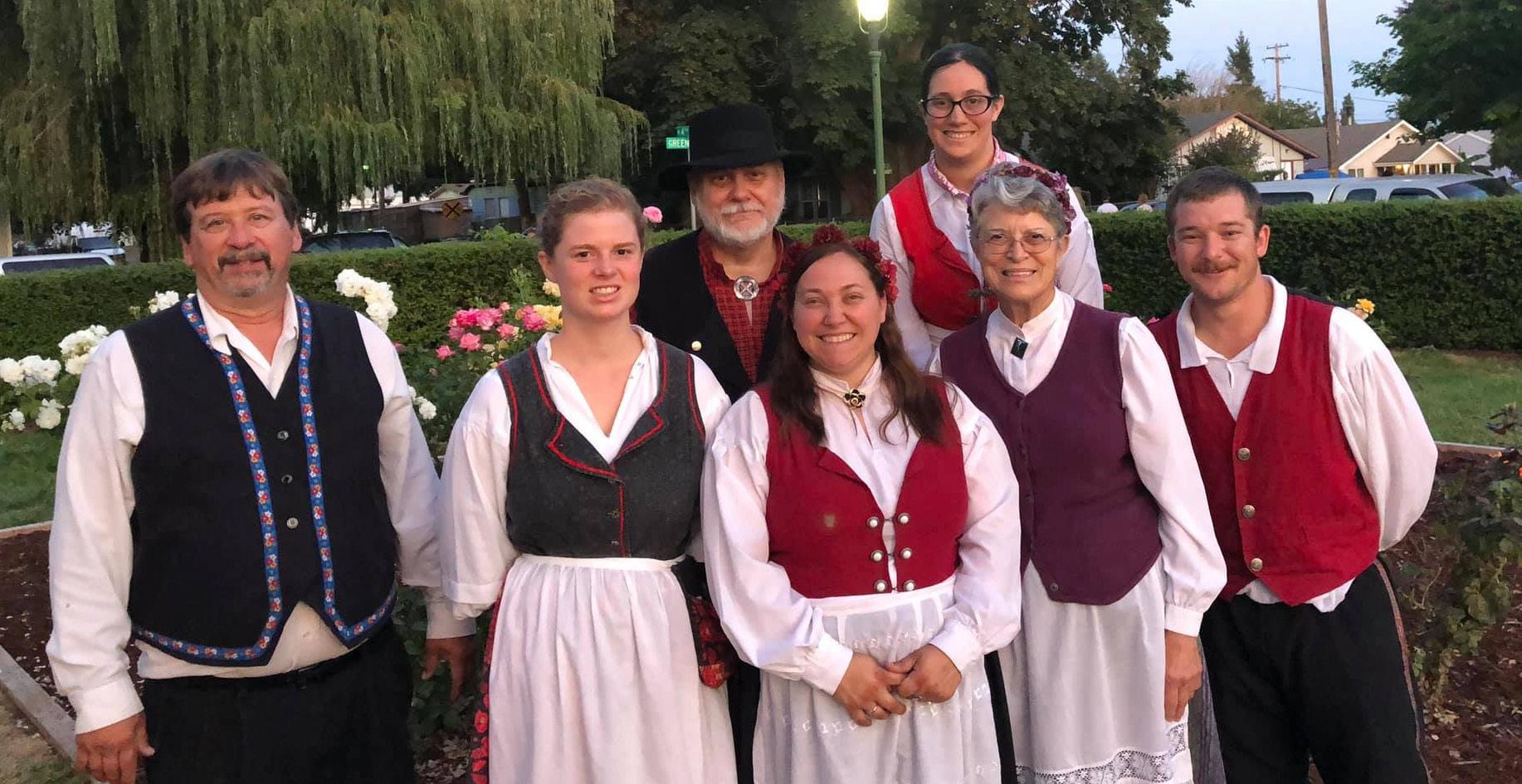
The Tirolean Dancers were formed in 1979 by four couples. They wanted an authentic and professional group that focused on Schuhpattler and Volkstonz dances. These dances originated in the Bavarian and Tyrol area of southern Germany, Austria, the German speaking area of Italy (called South Tyrol) and areas of the Swiss Alps. Schuhpattler dances include stomping, clapping and striking shoes, thighs and knees. Volkstanz dances include the waltz, landler and other multi-cou ple figures. They perform in Bavarian costumes, called Tracht which refers to men’s and women’s traditional clothing.
The group practices weekly under the direction of Emily Moore, Jason Moore and Lyle Weden. Emily has been di recting the group since 2010. Emily says one of her favorite parts of par ticipating in the Festival is “walking around, enjoying the vendor shops, eating all the delicious food and danc ing, of course!” The group also enjoys visiting together while having a drink or two in The Wine Terrace!
One of the members of the group, Lyle Weden, has danced with the group for over 30 years and is the longest participating member. His influence in working with the group has helped them to stay traditional and true to the original forms of Bavarian dance. He says, they “try to be as authentic as possible!”
The Tiroleans perform in the late summer and fall. They’ve performed at Oaks Park Oktoberfest, Mt Angel Oktoberfest and Alpenfest at Wallowa Lake in addition to Junction City.
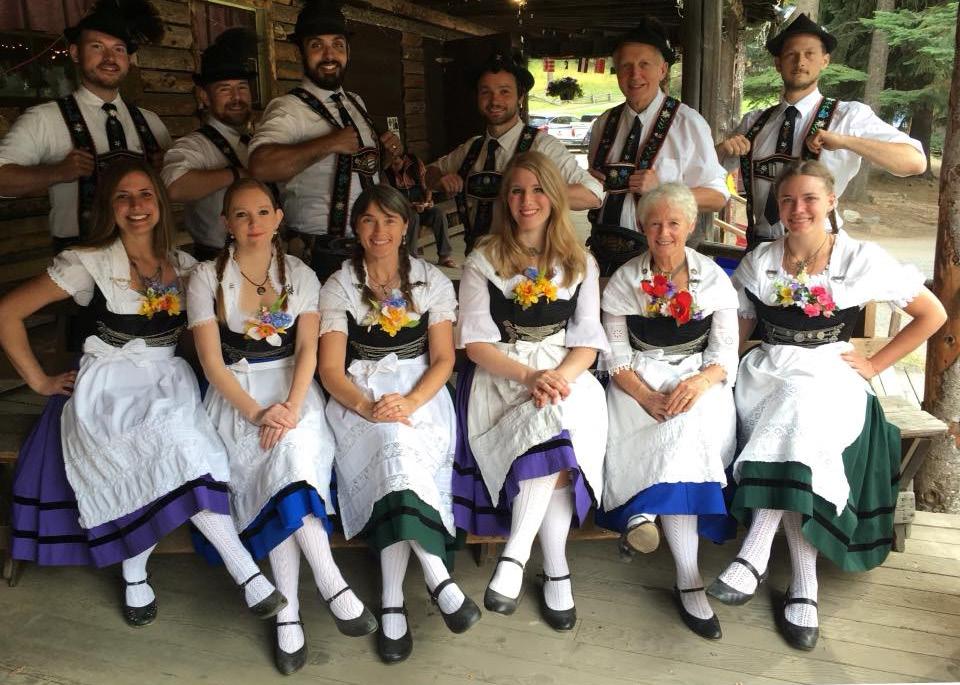
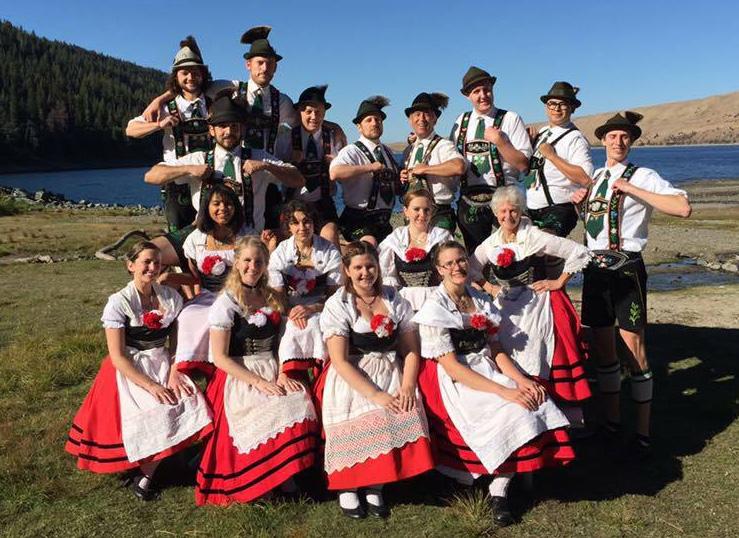
You won’t want to miss this colorful and dynamic group performing Sat urday at the Festival Park Stage!

Visit Norway each evening, at the Junction City Scan dinavian Festival’s annual pageant. This fun show lasts thirty minutes and will take place each day of the Festival, following closing ceremonies. Learn the traditions around solje (SOL-ya), jewelry that have magical properties of protection. The story will focus on the folklore of tom te and a sweet girl named Brita. You will find yourself transported to a farm, where Brita grows up alongside her beloved tomte and favorite pony, Otto.
Watch as Brita brings new adventures and excitement to her family’s farm. A good hearted girl by nature is still bound to make mistakes. Follow Brita from birth through her teen years, as she encounters life’s lessons on patience, respect, and making amends.
“Brita and the ‘Helpful’ Tomte,” was inspired by the traditions of solje. The presence of solje is said to repel trolls, and shield the wearer from the evils of the world. Norwegian in origin, this “shiny” style of brooch appears throughout the Scandinavian world. The first solje is presented shortly after the birth of a baby. The second solje is given to a young woman when she turns sixteen. The final piece, usually in the shape of a heart, is presented to a new bride, as a bridal gift from her groom.
The muse for this year’s story is the feisty, but well inten tioned tomte - also known as nisse. Often confused with garden gnomes due to their undersized stature and hats, tomte are found on farms and provide good fortune to any farmland it serves. Loyal to their land and family, tomtes have more good traits than bad, but their short tempers can get the best of them. Luckily, they can be appeased by some good food and a genuine apology. You can find many tomtes hiding around Festival, look for the tomte scavenger hunt here in this magazine.
Museum BY TARYL PERRYThe Scandinavian Festival started with a thought on how to bring more traffic and recognition to Junction City, which was then proposed to the Junction City Chamber of Com merce who donated funds to help stage the first Festival. The need for volunteers went out and local community members stepped up to help.
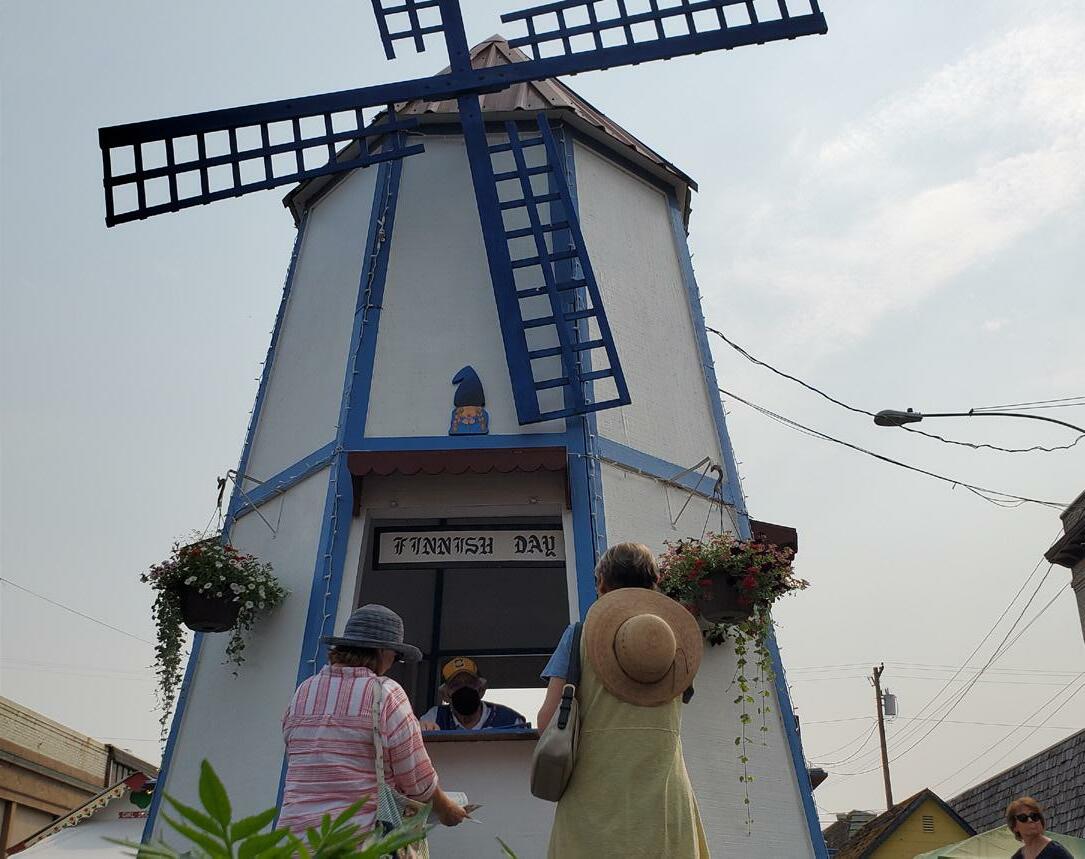
Throughout the 60+ years, volunteers have collected newspaper clippings, photos, programs, and brochures to remember each step of the way. Costumes have been do nated and other memorabilia such as the Viking dolls sold at the first Festival have been carefully stored.
During the early years, KEZI would bring out their news anchors and reporters and do the evening news from down town Junction City. They filmed hours of music, dancing, the nightly pageant, people wandering through the food and craft vendors. Four years of these TV film reels, (‘69, ‘72, ‘73 and ‘74) had been located. Local author and journalist Mike Thoele worked with the University of Oregon to trans fer the hours of TV film to CD’s, which will be on display.
For the 50th Festival, a museum was created in a downtown storefront where brochures, photos and other memorabilia were displayed. For the 60th Festival a museum was once again set up, this time in Festival Hall. In addition to even more of the previous items, authentic costumes from Nor way, Denmark and Lapland were included. It has become a popular and interesting addition and we are happy to display some of that history again.
We hope you enjoy the show!

Depending on whom you speak with, the word Scandinavian can encompass only Denmark, Sweden, and Norway; or it can also include Finland, Iceland and the Faroe Islands. In Junction City, we have traditionally celebrated Den mark, Norway, Finland, and Sweden, and sometimes Iceland will get a moment in the spotlight as well. Over the next 5 sections you’ll learn a bit about 5 of the 6 listed countries and even find some recipes common to them. Each recipe was specially picked so that at the end of your journey through Scandinavia, you can prepare a full meal representative of what Scandinavia has to offer.

Denmark: Called Dannebrog, meaning The Cloth of the Danes. Flag Day is celebrated on June 15.

Finland: Called Siniristilippu – or Blue Cross Flag. Flag Day is celebrated on June 20-26 on Midsummer Day.

Norway: Often called Norges flagg - or Norwegian Flag. Flag Day is celebrated on Feb 6th.

Faroe Islands: Called Merkið, meaning The Banner or The Mark. Flag Day is celebrated on April 25.


Iceland: Often Called Ríkisfáni - or State Flag. No specific flag day, but has approved holidays to fly the flag
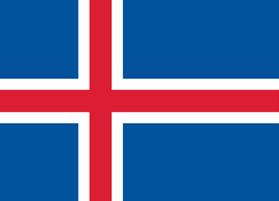
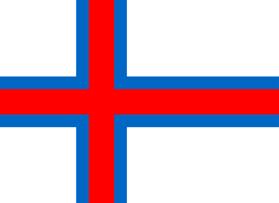
Sweden: Often called Sveriges flaggaor Swedish Flag. Flag day is celebrated on June 6th.

 BY AUDREY SHERMAN
BY AUDREY SHERMAN
Sweden is a beautiful lake-sprinkled country well known today as the origin of IKEA and the beloved pop band ABBA. However, even in modern Sweden today you can catch glimpses of unique folk traditions that have lasted centuries, some of which you can also see here in Junction City.
For starters, there are many tasty classic Swedish dishes we enjoy here at the Festival such as Swedish Meatballs, “köttbullar”. Distinct to Sweden is the addition of lingonberry jam served with the meatballs. Lingonberries are harvest ed from the forest and tundra of the central and northern regions of the country and make a delicious sweet and tart jam or sauce. This can be served with a variety of foods, including potatoes, herring, and pastries.
Another interesting part of traditional Swedish cuisine stems from 18th century Sweden when spices such as salt and pepper were imported and very expensive. Foods were often seasoned with what could be locally grown, includ ing onion, dill, parsley, and horseradish. These spices are common even in Swedish dishes today. Pickled cucumbers is one of many dishes in Sweden that relies on dill for its distinct flavor. Boiled potatoes are another staple side dish often seasoned with dill, though potatoes didn’t become common until well into the 19th century.
In addition to the tasty Swedish foods at the Festival, you can also witness traditional Swedish folk dances. Common dances in Swedish folk tradition include the polska, hambo, mazurka, schottis, langdans (long dance), and gånglåt (walking dance). The most popular type of dance is the polska which is a ¾ time dance believed to originate in Scandinavia around the 16th century with Polish influence. A Sweden-specific type of polska, the hambo, is widely popular and believed to have originated in the early 20th century and remains popular today. You will likely see this dance at the Festival, and if you happen to visit Sweden during the summer, you might be able to see the Swedish national hambo compe tition that occurs each year.
To accompany these dances, the most popular instrument is the fiddle. The fiddle was introduced to Sweden in the 17th century and in the 18th century became the most popular folk instrument. Another instrument signature of Swedish folk music is the nyckelharpa, Sweden’s nation al instrument. The nyckelharpa is a 16 string fiddle with keys that change the tune of the strings. The origin of the nyckelharpa is confusing due to many similar instruments being depicted across Europe between the 14th and 16th centuries. However, it has been consistently played in the Uppsala region of Sweden since the 17th century and is known as a Swedish instrument today.
Sweden has a unique history of tradition to remember and celebrate. To bring a piece of it home, you can try to make your own Swedish potatoes, which would pair well with the other recipes highlighted from the other Scandinavian countries in the following pages.
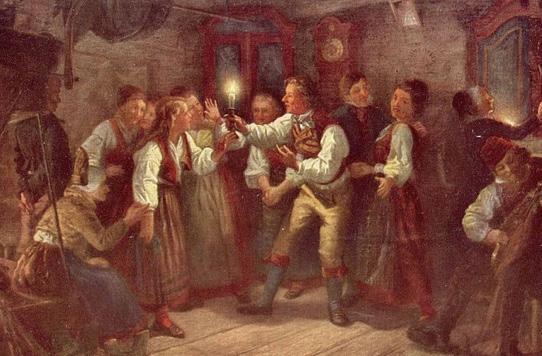

Ingredients:
3/4 kg (just over 1.5 lbs) potatoes, (new or regular potatoes)
1 tbsp butter, unsalted
1 tbsp flour, (heaping tbsp)
1/3 cup heavy cream
Instructions:
1. In a medium to large pot, boil potatoes until tender. After removing the water, place the pot back to the heat for 2 to 3 minutes to remove additional moisture from the cooked potatoes. Set aside.
2. In a small saucepan, melt butter. Add flour. Mix until flour has turned into a soft paste.
3. Add cream. Whisk to avoid getting clumps.
Slowly add milk, continue whisking. Simmer for around 5 minutes.
Season with salt and pepper. Add nutmeg, if desired.
Cream mixture would be slightly thicker now. Mix with spatula or wooden spoon, scraping the sides of the pan and making sure that there are no lumps in the cream.
Pour cream mixture to cooked potatoes. Mix.
Add chopped dill. Mix to combine properly. (Try to coat each potato with cream and dill.)



During the1860’s to 1910’s, 75% of the Danish population resided in rural areas. Farming was the greatest source of income for the country and about 2/3 of farm production was exported to England and other countries. Most of the food consumed consisted almost exclusively of products grown or produced in Denmark. Meat, fish, vegetables and fruit were common and were eaten fresh in the growing season and salted or smoked and dried or pickled in the off season.
Frikadeller (Danish meatballs) was a common dish then and is now as well. Many towns had a baker who baked all the bread for the community because home ovens were banned due to fire danger. Townsfolk would find alternatives to baked goods such as cakes boiled in lard or vegetable oil and aebleskiver baked in hot irons in the fireplace. After its invention in the second half of the 19th century, the cast iron stove came into common use replacing the fireplace. Baking became more creative with the availability of a more efficient oven resulting in many of the popular Christmas cookies we enjoy today such as vaniljekranse, known in the US as Danish butter cookies.
During the growing and harvesting season there was lit tle time for anything other than farming chores and food preparation. But in the off season folks engaged in other pastimes. Dancing was a common pastime for Danes be cause it was simple enough for everyone to participate. These dances included the waltz, hopsa, schottische, pol
ka and contra/square dance variants. Many folks played instruments such as the fiddle and some towns even had officially appointed musicians called stadsmusikanter who played together with their apprentices at family gatherings, local festivities, and churches.
The Denmark monarchy is one of the oldest in the world and is constitutional which means the monarch cannot in dependently perform political acts. Since 1513 every Danish monarch has been named either “Christian” or “Frederik” with the names alternating between father and son. For example, the monarch who ruled between 1863 and 1906 was Christian IX. His father was Fredrerik VII and his son was Frederik the VIII. He and his wife Louise Hesse-Kassel had 6 children which were Frederick (who became Freder ick VII), Alexander, George, Dagmar, Thyen and Valdemar. Christian IX was known as the Father-in-law of Europe as many of his children married into other royal families and his many descendants were European royalty.
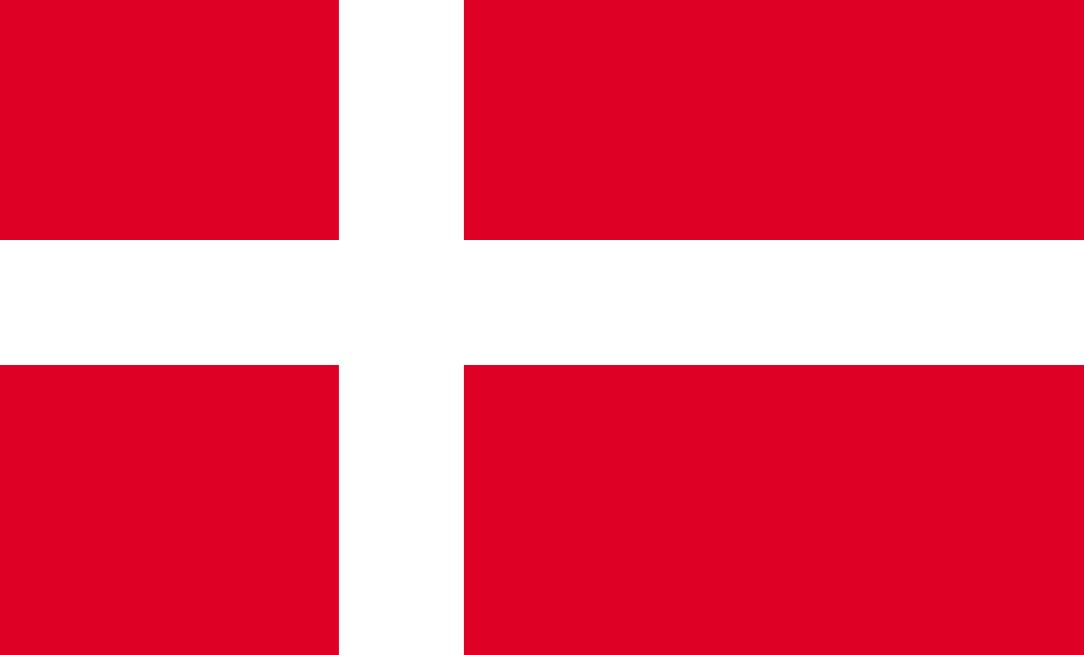


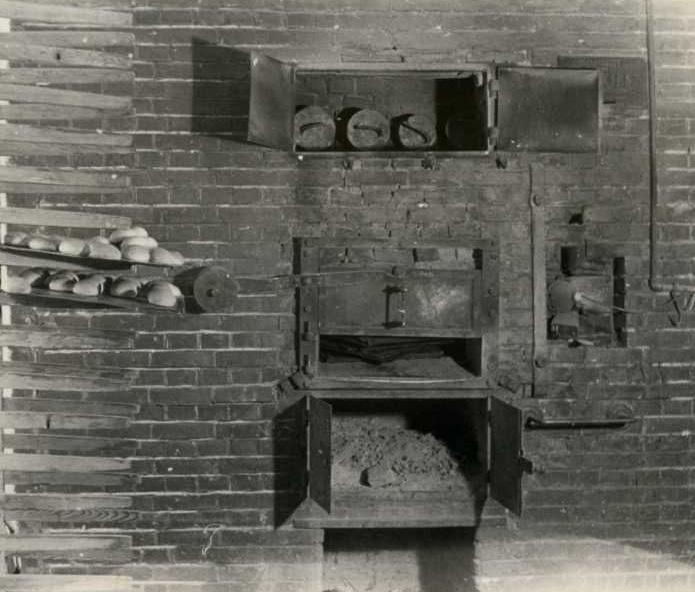

 BY MARCI HANCOCK
BY MARCI HANCOCK
Between 1870 and 1900, nearly twelve million people from around the world settled in the United States. People left their homelands and immigrated to the United States for a variety of reasons. America is a melting pot of cul tures and traditions. Every ethnicity has influenced our unique American culture, and the Finns are no exception.

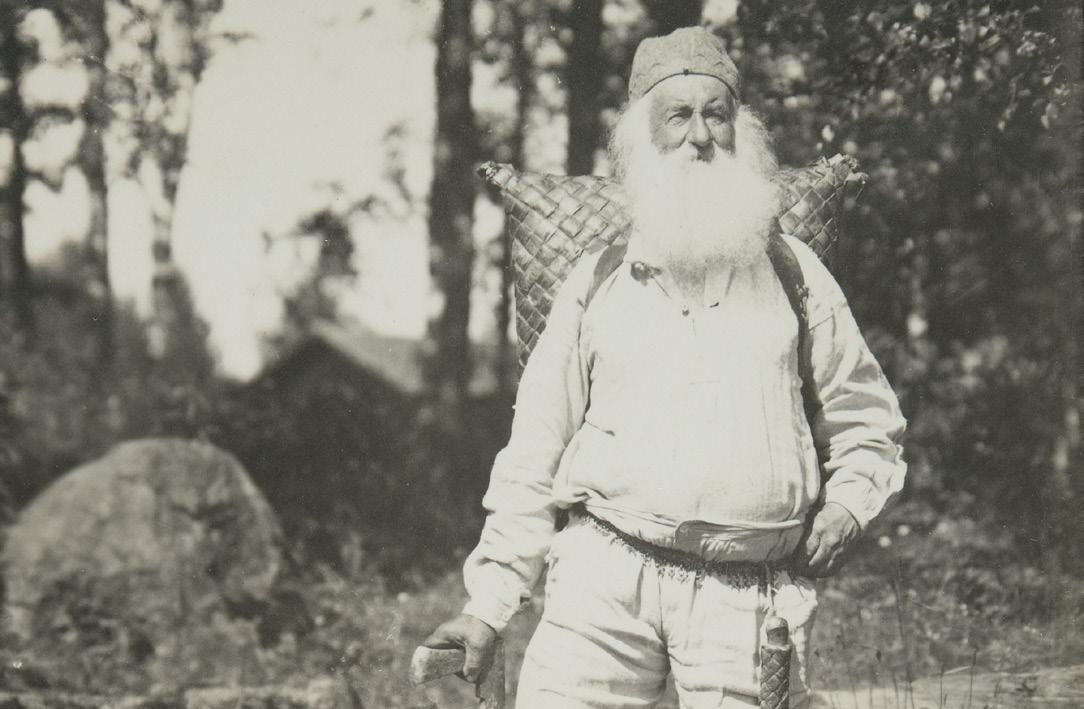
shevik Revolution of 1917 derailed that effort. National pride bloomed in the wake of independence, and Finnish grammar schools were established throughout the country, preserving Finnish as the national language.
Russification, combined with a downturn in local agriculture, caused a mass migration prior to independence. This drastic upheaval of the population is known as the “Great Migration of the Finns.” Ten percent of the population moved to other lands, with a large majority of them heading for America. Many Finns planned to return home after they made their fortune. However, only twenty percent returned.
Finland’s history prior to the early 20th century is one of foreign rule and occupation. Prior to 1809, Sweden ruled over Finland for over six hundred years. Finland’s working class made up the majority of the population. Limited transportation options kept the small communities together, and local tradition and customs ruled the day. Finnish was still spoken throughout most of the country, with just a little Swedish. The urban-dwelling higher class spoke more Swedish than the country folk, but was a small percentage.
In 1809, the Russians pushed the Swedes out of the coun try, Russia began a program of assimilation called “Russi fication.”, which aimed to eliminates Finland’s culture and erase its borders, expanding Russia. Russification efforts in Finland would have likely been successful, but the Bol
Once in America, Finnish settlements took root, mainly in the upper Northeast and Northwest regions. America, having vast forests and plenty of farmland, was an ideal fit for Finns immigrating to the country. In Finland, during this period, 70% of Finns worked in agriculture. Forestry was another industry that was familiar to the Finnish people. Many immigrants remained in the old-country trades that they knew well. Others worked in the booming fields of the industrial revolution, mainly in mining and construction.
Finnish culture is found throughout the United States. In the 19th century, many Finnish towns centered around a par ish church, usually Lutheran in denomination. Rural American towns still have reflections of Scandinavian heritage with white wooden church buildings adorned with tall steeples. Another iconic structure in America is the log cabin, which is based on a Swedish-Finnish design.
Alongside their faith, forestry knowledge and cabin making skill, Finns also brought their style of dairy farming to the United States. In Finland, farming was not always prosperous, chores were difficult, and milking livestock twice daily was a time-consuming task. Communities banded together, forming dairy collaboratives to share the workload.
It’s easy to see that America today would be a very different place without Finnish influence. Their culture and traditions were accepted and saved, and became a part of our nation’s story. Time and struggles could have swallowed the Finnish identity and language, but the Finns held strong, preserving their way of life. They wove new stitches in their homeland and in America, leaving their mark on today’s world.
Sima is a traditional Finnish mead fermented from sugar and yeast. The fermentation process leaves the low alco holic mead slightly sweet with a sparkling effervescence and a lemon, caramel flavor. ‘Sima’ is the old Finnish word for ‘honey’, which is traditionally used in the fermentation of mead. Traditionally Sima is enjoyed as a seasonal drink during the spring and summer, often used to celebrate the Vappu Festival. It pairs well with traditional sweets: munkki (donut), a tippaleipä (a special Vappu funnel cake), or a rosetti (rosette).
• 32 oz. water
• ½ cup white sugar
• ½ brown sugar
Instructions:
• 1 lemon, zested
• 2 tsp active dry yeast
• 10-12 raisins
1. Combine water and sugars in medium pot, stirring con stantly over medium-high heat until sugar is dissolved.
2. Remove sugar water from heat and let cool to 100°F. Once cooled, remove a half cup of water to separate bowl. Add yeast to ½ cup of water. Make sure water is at 100°F or it will kill yeast.
3. Zest lemon, cut and discard pith from lemon flesh, as it will cause bitter flavor. Cut lemon into slices. Add lemon zest and flesh to pot of warm water (without yeast).
4. Once yeast has bloomed, pour it into pot with lemon sugar water. Cover with plastic wrap, or tea towel secured with a rubber band. Let sit for 24 hours, undisturbed.
5. After the 24-hour brew, remove lemon from liquid. Pour liquid in air tight container. Place 5-6 raisins per 16 oz. of liquid. Tighten lid and set to brew for 1-7 days. Once raisins float to the top, the Sima is ready to drink but can sit longer if desired. The longer the brew, the stronger it becomes, both in flavor and ABV content.
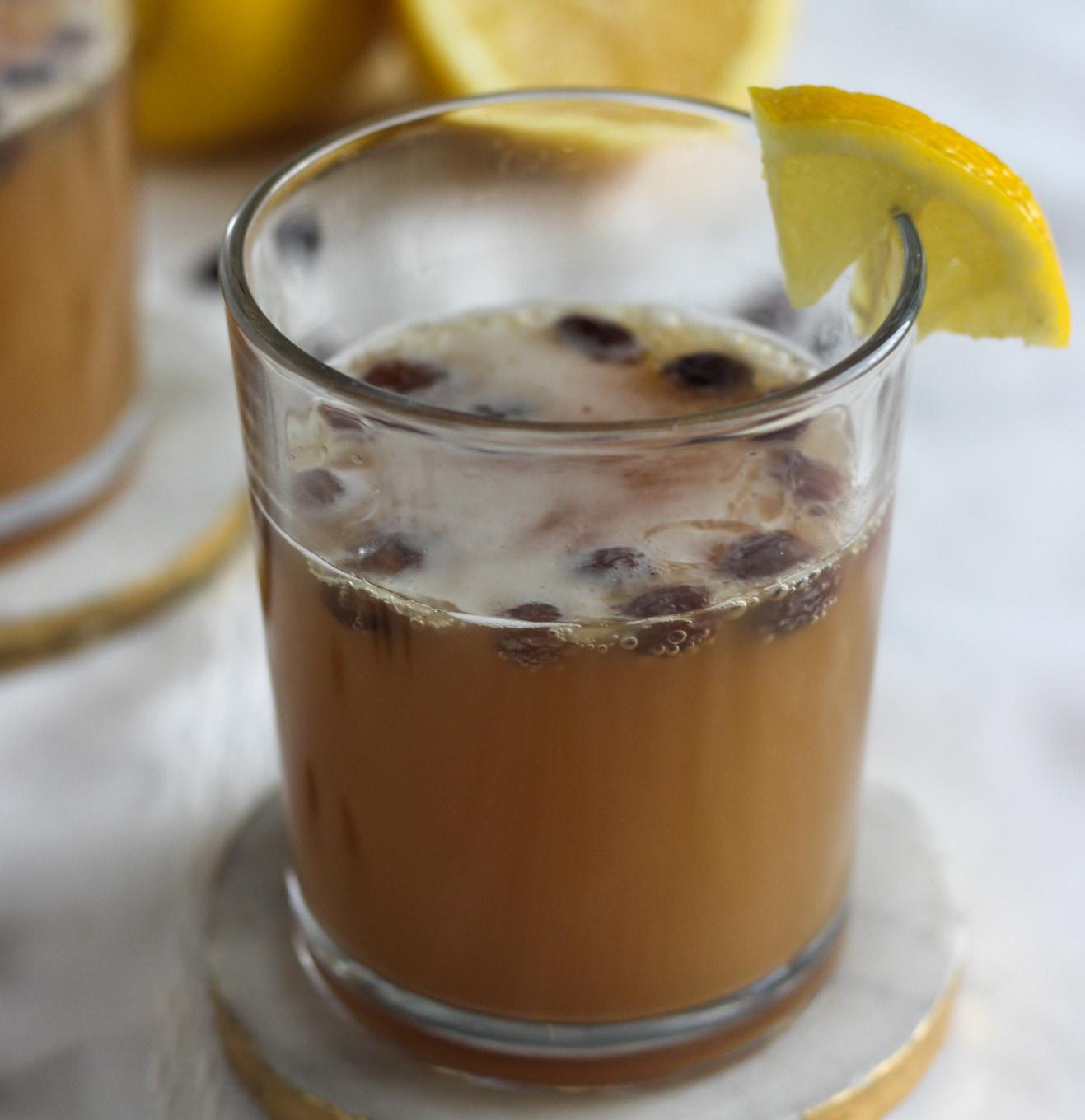
• https://monovisions.com/vintage-helsinki-in-the-late-19th-century-1890s/
• https://localhistories.org/a-brief-history-of-finland/
Iceland is a beautiful country with seemingly conflicting land filled with glaciers, volcanoes and volcanic vents. The capital city, Reykjavik, was named after these vents by the first settlers of Iceland. These settlers are very well recorded in Icelandic literature, as well as many of their descendants. Because of this literature, much of Iceland’s history is very well documented.
When hearing of the country Iceland, it likely brings to mind a frozen, ice covered countryside. While this is accurate, with over 260 named glaciers in and around Iceland, surprisingly it also has around 200 volcanoes, 32 of which are active. Iceland also has the most hot springs and volcanic vents of any other country. These volcanic vents can be seen all over the island, and were the namesake for the city of Reykjavik. When settlers first saw the steam billowing out of the vent on the shore, it was called ‘Reykhavik’, which means ‘Bay of Smoke’ in Icelandic.
Glaciers cover about 11% of the island itself. The largest glacier, Vatnajokull, lies in the southeast of the island like a hulking, frozen mountain and is Europe’s largest glacier. Interestingly, Vatnajokull glacier rests in the same location as Iceland’s most active volcano system, Grímsvötn, with its most recent lasting from August 2014 until March 2015. This geological occurrence is quite common in Iceland, causing jökulhlaup, or ‘glacier run’, which is essentially flash flooding caused by rapidly melting glaciers from volcanic activity.
Much about the first settlers of Iceland is known because a written account of the immigrants and history was recorded in two books: Libellus Islandorum (The Book of the Iceland ers) and Landnámabók, (The Book of Settlements). Both of these accounts were written, either in full or partially by Ari Thorgilsson the Learned in the mid 12th century. The Libellus

Islandorum details the history of Iceland, from the time of settlement, until around 1120 AD and includes information about how they formed the Althing (parliament), which is the world’s oldest democracy. The Landnámabók, records around 400 of the original settlers, including their spouses, descendants, and landholdings. In total, the book describes around 3000 people from 874 AD to around 1120 AD!
When Ingólfur Arnarson first arrived in 874 AD, it was likely they built turf homes, which were the same style of homes that most Icelanders built and lived in until the early 20th century! These homes were usually built by stacking flat rocks for foundations, birch logs for frames, then layers of turf for the roof. These homes were often seen as “dis posable” and while families lived in one home, there would often be another in construction for when the walls or roof eventually failed. Museums in Iceland have worked to keep historic homes maintained so that even now you can visit and tour old turf homes.
Food in Iceland has always centered around its most acces sible resource and profitable industry: fishing. Hearty meals often have a main dish of some sort of fish including cod, haddock, whale blubber, and seal meat. Some popular dishes are gravlax (salmon marinated in salt and dill), and hákarl (carefully putrefied shark). Don’t worry, the following recipe is not one of their more adventurous recipes, like hákarl .
Flatkaka is a traditional unleavened bread served on most tables in the Icelandic countryside, and has been a part of traditional meals since the time of Ingólfur Arnarson. Tra ditionally, this recipe is just two or three ingredients: rye flour, hot water, and sometimes supplemented with moss during times of scarcity.
C
mixture
water
stirring
very dry
Some dry flour
still be present, this
On lightly floured surface, roll out dough
1-2 mm thich, cut out rounds using a bowl or small plate
a guide. Pierce rounds with fork.


fine.
dough in bowl or on floured surface
it

together.
Cook each round, one at a time, in a hot skillet or crepe pan, about 1 minute on each side, or until edges become golden brown.
Immediately after cooking, quickly dip bread into lukewarm water (to prevent it drying out) and put on a plate under a damp dishcloth.
Recipe yields around 5 flatkaka Serve buttered with smoked meat for the most authentic taste.

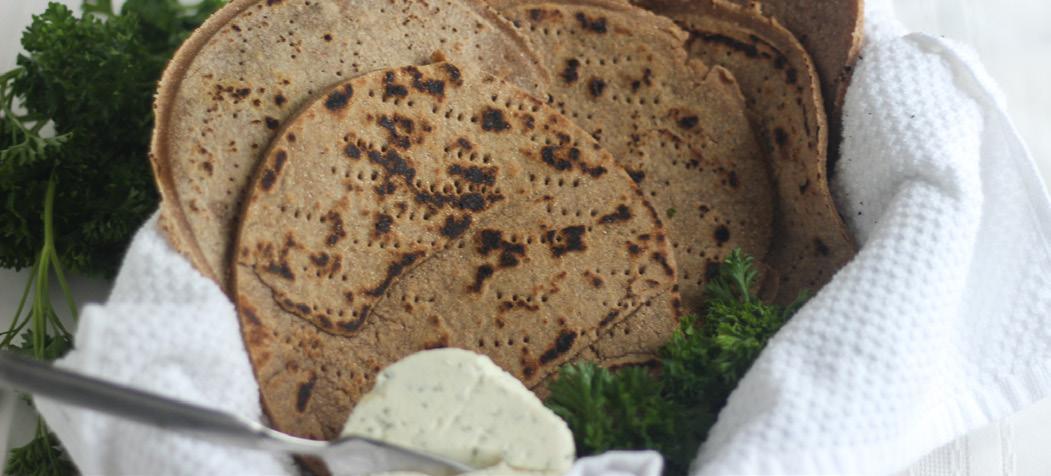
Each year in Junction City we celebrate the culture of Scandinavia by recreating the look and feel of a typical 19th-century Scandinavian village.
One of the countries we focus on is Norway. Called the “Land of the Midnight Sun”, Norway is famous for its beautiful fjords and majestic mountains. Tales of Vikings and trolls abound. Norway even has its own Royal Family. Despite its seemingly fantastic origins quite different from our own, did you know that there are currently more peo ple of Norwegian descent living in the United States than actual Norwegians living in Norway? Clearly, Norway likes to share its culture with the world.

This year, Junction City (incorporated in 1872) is celebrat ing its 150th birthday and we wondered if we could find any similarities between our town and a typical Norwegian village of that time period.
Vossevangen (or Voss) is a village in the Vestland region of Norway that is currently approximately the same size as Junction City. Its history stretches much further back of course. For example, its stone church dates back to 1277. Junction City, aside from its earlier Native American inhab itants, is a relative newcomer to the cultural scene.
Despite the differences in the age of the two settlements, residents of Voss and Junction City in the 1870s actually had much in common. Both communities were for the most part based on an agrarian economy with families living on small farms producing their own food and occasionally selling their products to others.
Junction City and Vossvangen are also both railroad towns. Our town was originally planned to be a railway hub, plotted by the famous railroad tycoon Ben Holladay. Although this plan never came to fruition, the community still benefited from the advent of rail lines in the area. Voss on the other hand had a much more successful railway experience. It became part of the famous Voss train line which eventu ally connected the cities of Bergen and Oslo. The ability to transport passengers, timber, and other commodities brought new prosperity to the region.
Vossevangen and Junction City share a history of immigra tion. Immigrants from Voss were some of the first Norwe gians to come to the United States during this time period, with the first family arriving in 1836. Many Voss immigrants settled in Illinois, Wisconsin, the Dakotas, and Northern Iowa. Coincidentally, Junction City’s emigrant experience also involved settlers in Iowa, this time Danes who moved from the Midwest to settle in our town in the early 1900s.
As noted, residents of Junction City and Vossevang alike relied on farming to sustain them. One crop they both might have cultivated is rhubarb and it’s entirely possible either would be delighted by a piece of Rabarbrakake or Rhubarb Cake for breakfast or after their evening meal. Rhubarb was first introduced to Norway in the 1700s as an ornamental plant. Its hardiness allowed it to survive the harsh Norwegian winters and its appearance each year marks the beginning of the spring season. In the 1800s it became common for Norwegians to cut a stalk of rhubarb, dip it in sugar, and eat it raw. When sugar became more easily accessible this cake made its debut. Today it is a pop ular staple in homes and restaurants across Norway. Many Americans also love eating rhubarb, which was introduced to the United States by Ben Franklin, also in the 1700s, so we hope you will enjoy this recipe as well.
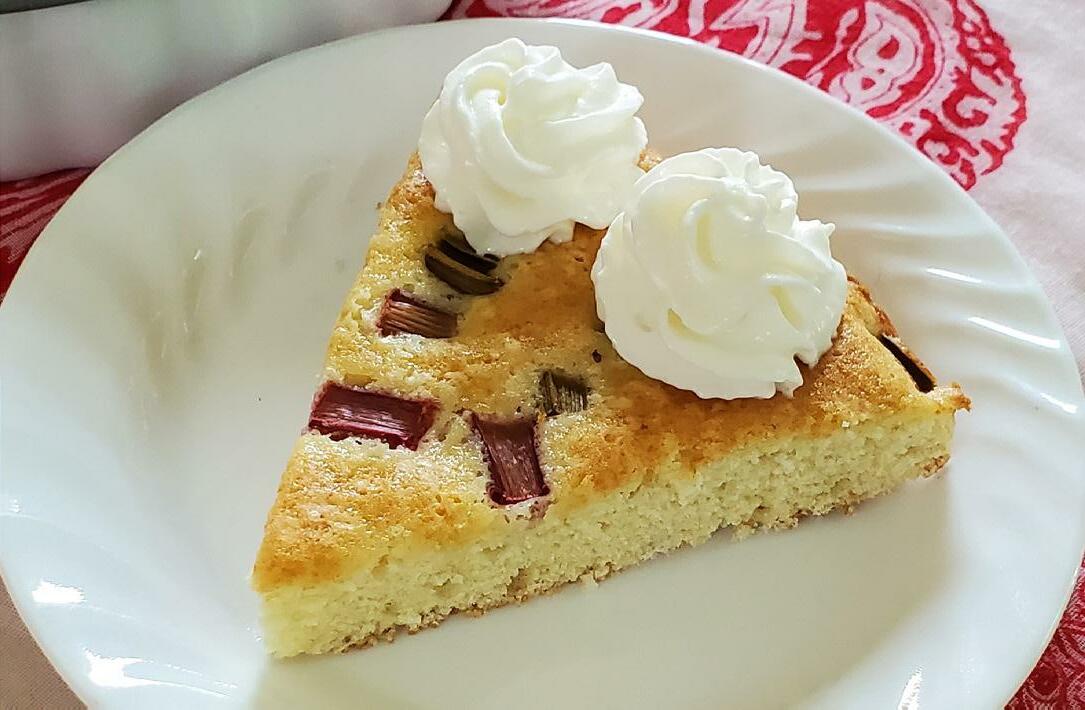
Ingredients:
1. Preheat the oven to 350°F. Melt butter in small saucepan over low heat. Remove from heat and stir in milk. Meanwhile, beat eggs and sugar together until light and fluffy. While continuing to stir, slowly pour in melted butter. Add flour and baking powder and mix until combined.
2. Pour batter into 8-inch springform pan and sprinkle the rhubarb over the top, making sure the rhubarb doesn’t touch the sides of the pan. Bake until a toothpick inserted in the cake comes out clean–this took about 30 minutes, but check it in advance. Allow to cool and carefully remove from pan. This cake would be lovely served with whipped cream, as the original recipe suggests, but is also delicious plain.
• https://en.wikipedia.org/wiki/Vossevangen
https://commons.wikimedia.org/wiki/Category:Vossevangen
https://en.wikipedia.org/wiki/Voss_Line
• https://www.ilovebergen.net/bergen/everything-you-need-toknow-about-the-bergen-railway/
• http://www.vosselag.org/vosselaghistory.html
Recipe from:
• https://outside-oslo.com/classic-norwegian-rhubarb-cake/
• https://freepages.rootsweb.com/~anderson1836/genealogy/ norwegian_life.htm
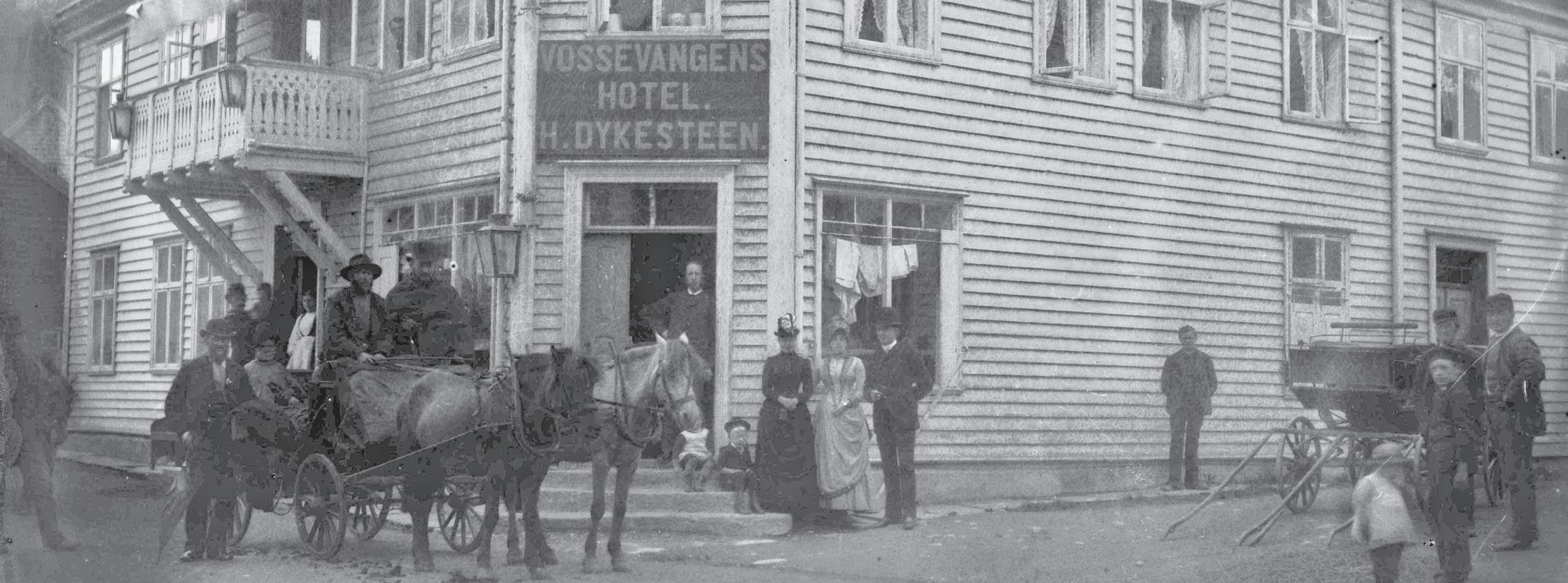
• https://monovisions.com/vintage-everyday-life-in-nor way-19th-century/
https://talknorway.no/norwegian-railway-history-the-pio neer-era-1851-1868-norway/
https://www.lifeinnorway.net/voss-norway/
• https://en.wikipedia.org/wiki/List_of_urban_areas_in_Norway_by_population

members are
and healthy.
We hold activities all through the year to build community near and far around our Scandinavian heritage, from free dance groups to the Aebleskiver Breakfast. Let’s keep that Festival feeling going strong, all year long!
people who keep this project
than ever, that matters.
Festival was organized in 1961 to vitalize the business community of Junction City and help local businesses thrive. This has always been part of our mission, and it’s never been more important than now.
Together, we offer an annual $1,000 scholarship to a deserving local high school graduate. And year after year, our free, high-quality children’s dance program changes lives and builds confidence.
What does it mean to become a Member? There are a lot of great reasons to support the Scandinavian Festival with a purchase of a Membership. It’s not just about the fancy pin that you’ll get with your Membership purchase, though that is a really good reason. More information about this year’s pin below.
Every membership purchased means so much to the Scandinavian Festival and its volunteers; with each membership commitment it says, “we value this event and stand behind the volunteers who run it.”
When shopping for a Membership, know that your support makes a difference. There are multiple levels of membership, but every purchase is greatly appreciated. Thank you for your contribution. Junction City Scandinavian Festival members are special people that are held in high regard in our community.
This is the fourth pin in the current series of dancing couples and features dancers from Norway. This pin com memorates the 61st Junction City Scandinavian Festival.
The pin features a white ring around the dancing couple with “Norway” in a scroll at the top of the pin and “Junc tion City Scandinavian Festival 2022” is at the bottom. Both are written in black lettering.
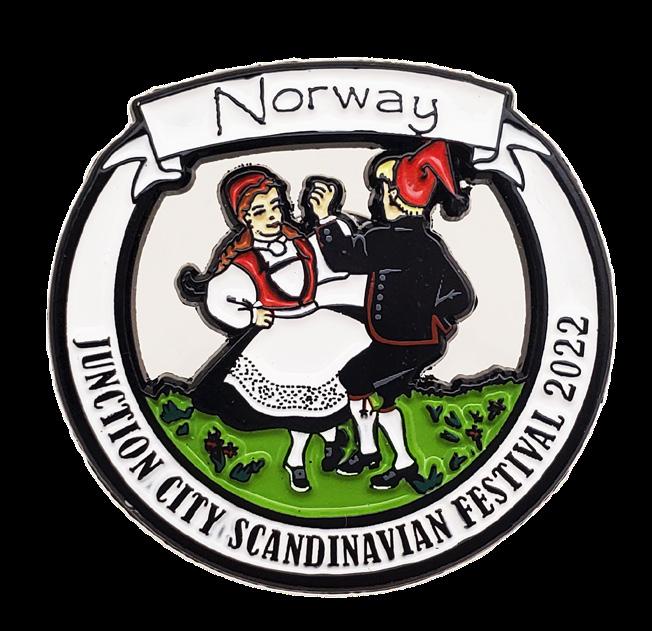
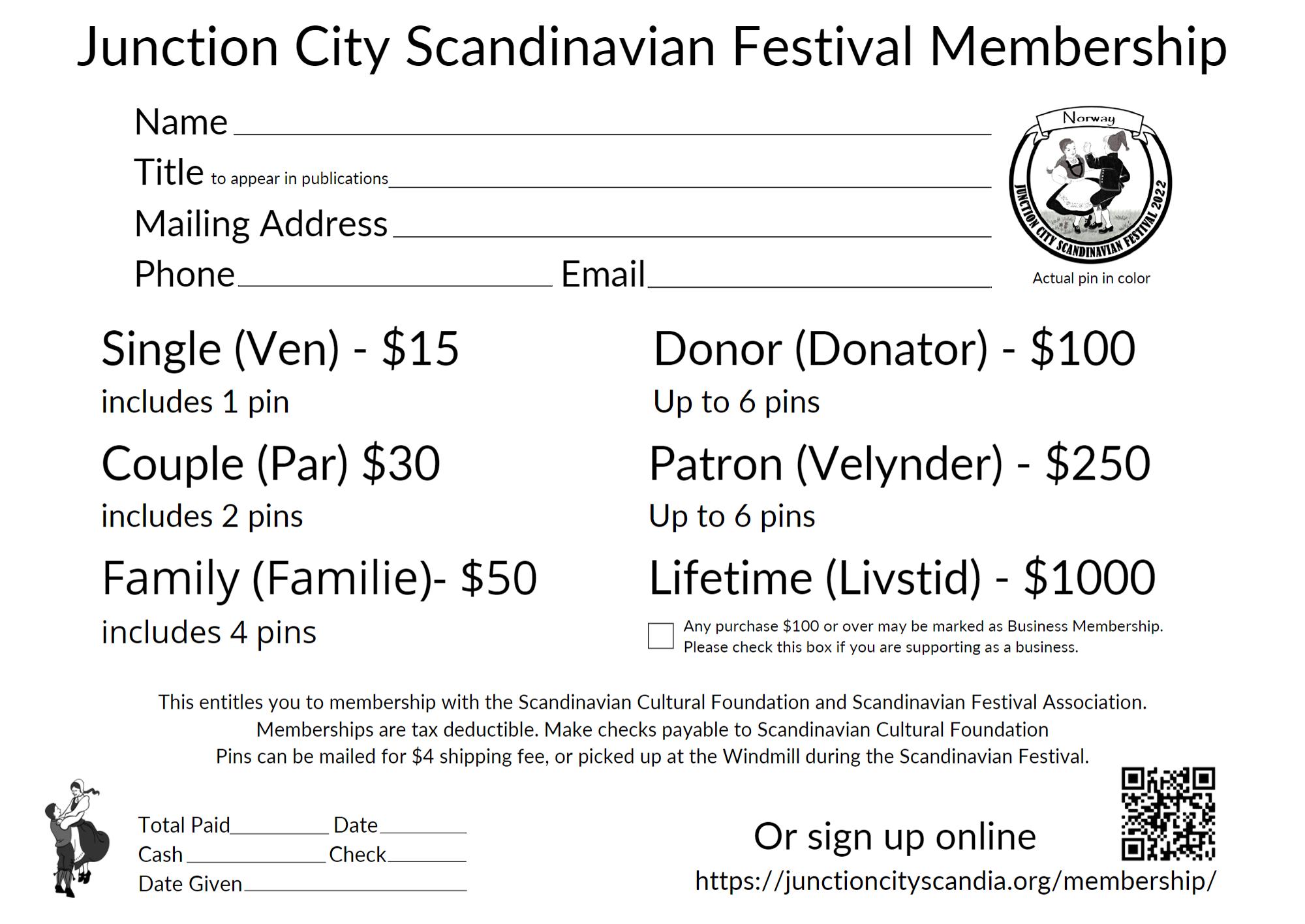
The couple depicted are wearing cos tumes representative of the Hardan ger district in western Norway. The Hardanger traditional costume was the first to evolve into a bunad at the
end of the 1800’s and is known as “the first bunad”. Women wore this to show their support for independence from Sweden. Due to this event, the bunad came to earn the nickname “Nasjonalen” (the National). If you are in Norway on National Day (May 17th), the streets will be full of Norwegians all wearing traditional bunads. On this pin the woman’s Hardanger bunad has a black skirt, red bodice and white apron with Hardanger embroidery (or Hardangersom) accents on the apron. The man’s Hardanger costume has a red vest, white long sleeved shirt, black knickers, black jacket and white socks. Both dancers wear silver brooches at their necks and black shoes.
The couple is shown in a pose as they are doing the Schottische, or Rein lender, the name it is called in Norway. The man is turning the lady under while doing the schottische step. The Schottische is a common dance in Nor way with many variations, composed of multiple steps and step hops. The dance can be done in an open position or a closed position. Some of the varia tions on this step consist of turning the lady under, moving forward and back, separating and returning together and rotating as a couple.
A special thank-you to Jeanne Simpson for helping with the artwork on this pin!
These membership pins will be avail able for purchase at the Windmill during the Scandinavian Festival.
541.998.9372 for more information.

Individual - Diane Ballintine | Vicki Balter | AshlyAnn Lemhouse Debbie Benson | Melissa Coon | Ellen Costello | Natalie Franklin Traci Garets | Doug Heydon | Frank Jimerson | Blaze Lemhouse Krystal Lemhouse | Leigh Lemhouse | Rosemarie Mello | Sue Scott Sheila Mullens | Nicole Nystrom | Linda Peterson | Hau Ruan Kathy Solheim | Kathleen Wiggins (In Memory of) | Rebecca Wilson
Couple - Alec & Elizabeth Byrd | Aileen Drongesen | William Wofford Jerred, Amber, Audrianna, & Ashlen Flohr | Rich Foss | Trudy Graf Sandra & Bryce Halomen | Nels & Patti Iverson | The Tomsky Family Brad & Debbie Lemhouse | Hayden & Paige Lemhouse McClellan Don & Carol Nielsen | Carl & Taryl Perry | Russell & Marla Weber Graham & Courtney Steffan
Family - Chris, Jilena & Callan Dotson | | Daughters of Norway Scott, Mary & Mozelle Lemhouse Nelson | Ryan & Jenifer Skiles Family Jason, Rebecca & Oliver MacDonald | Mary & Nikki Wisegarver Matthew & Cassie Wicks Family | The Payne Family Heather, Alvia, Paige, Rory & Sophie Stiles
Donor - The Holton Family | Jeff & Jessica Peterson & Family
Business - Junction City Farm and Garden

Patron - Mark and Jen Crenshaw
Lifetime - Philip, Megan, Sarah, & Kate Peterson
Gale Fletchall Lifetime Achievement Award Recipients - Verne & Alves Andresen | Helga and Hans Rasmussen | Viola West Christine Nielsen | Marv and Mary Krenk | Vard and Peggy Nelson | Fran Wilger | Jock Loths | Walt Peterson | Jeri Beard | Dean McKay Wayne and Gretchen Leiberg | Brad and Dee Lemhouse | Karen McCumsie Nielsen | Karsten Rasmussen | Chuck and Sandy Toftdahl Jack Dutchess | Mike Curley | Pacific Power | Nadine and Mitch Wiles | John and Polly Gunson | Joanne Hunt | Gay Blankenship | Jo Brown Joen N. Bodtker | Theodore E. Jensen | Roy Chapman | Dorothy Young | Victor Nielsen | Arnie and Elaine Anderson | Fred Barden City of Junction City | Sue Huntley | Tom Johnson | Helen Sill | Fred Peterson | Vard Nelson | Elmer Borgaard | Bing Nelson | Kathy May Russell Jones | Karl Pederson | Gale Fletchall | Carl and Enola Nielsen | Russ, Marla, Julie, and Jon Weber | Orine Brunscheon | Taryl Perry Don and Carol Nielsen | Jamie Hooper | Tom and Brenda Peterson | Kay Slaton | Junction City Fire Department | MaryLou Finigan Tri-County Chamber of Commerce | Brett and Laura Lemhouse | Glenna Barker |Rod Lemhouse | David and Melany Vaughan Winn and Mary Wendell | Dean and Kathleen Huston | First Christian Church of Junction City | | Dottie Chase


Most of this magazine is about all the things you can see at Festival. This little corner is about what you don’t.
Is there something you think should be at Festival? Do you remember a special booth from years past we don’t have anymore? Is there a vendor you think should be part of our event? Is it you?
Festival is always looking for new ven dors to support the traditions and ex periences we all love seeing. It would be great to know what you miss from the past. It would be great to know about something new you’d like to see at Festival. And if you know what just the perfect booth would be, please reach out and let us know.


In food vendors we’re always looking for people who can present booths that have a great take on traditional Scandinavian foods, booths that celebrate our current community, and vendors that can give a Scandinavian twist to their offerings.

And in craft vendors, we’re looking for artisans who bring a knowledge of traditional techniques, offering products made by hand, people who are making things locally, and making things beautifully.
Whoever you have in mind, send them our way. We love to have potential vendors apply and see if we can make a good fit. It’s not necessarily easy to be one of the people that make Festival the unique event it is, but it’s very rewarding.
can go to the Festival website and find the Vendor Page
or you can write
